SBASSE History
Extracted From LUMS The First 30 Years by Hajira Kureshi
Inception (2002-2004)
Since 2002, Syed Babar Ali had been floating the idea of a science and technology venture under the aegis of LUMS, among expat entrepreneurs and academicians. In his perspicuity, Syed Babar Ali had realised that there was an urgent need in Pakistan for the ‘creators of knowledge’ instead of mere technicians, and he sought input on how to proceed. It may be said that the MBA programme had perhaps been simpler to conceptualise since the businessmen who set up LUMS were intimately familiar with the domain. However, in this case the process was different because Syed Babar Ali started by actively seeking guidance, advice and support for the idea; not merely within LUMS but by contacting academics and corporate executives based in the United States of America.
One of the first people abroad to respond to Syed Babar Ali’s queries was S. Atiq Raza, CEO of Raza Microelectronics, USA. He recommended that to steer and advance this venture, two categories of people should be targeted: industry leaders with strong academic connections and engineering leaders with a strong academic foundation. The first group would be able to provide strategic guidance as well as funding, while the second group would be likely to yield faculty, be it visiting or adjunct. In fact, it was Atiq Raza who introduced the venture to Hassan Ahmed, CEO of Sonus Networks, Inc. Soon afterwards, Mr. Ahmed became one of the first members of the advisory committee to the new School.
In March 2003 Syed Babar Ali presented the idea of launching a school of science to the Board of Trustees. The idea was given an enthusiastic go-ahead and it was decided to set up a committee which would devise a blue print for the venture. Bilal Zuberi, Management Consultant at the Boston Consulting Group, USA and PhD from Massachusetts Institute of Technology (MIT), was also among the first people contacted by Syed Babar Ali. It may be pertinent to mention here that Syed Babar Ali was travelling to the United States on a fairly regular basis at the time, because two of his granddaughters were studying at MIT. Mr. Zuberi strongly supported the idea of a science and technology institute and referred Syed Babar Ali to Drs. Salal Humair, Adil Najam and Farhan Rana. He felt their input would be valuable because they were the key individuals in organizing the Pak-Millenium Conference on Higher Education in 2002. Mr. Zuberi was in fact, the catalyst in Boston who got the word out regarding the science and technology venture that LUMS was considering. The group of advocates he rallied were informally referred to as the ‘Boston group’ in the initial days of the new venture. Interestingly, Dr. Humair went on to play a pivotal role for the new school and Dr. Najam became the third Vice Chancellor of LUMS in 2011.
At home, Syed Zahoor Hassan, then Vice Chancellor, was fully on board with the idea and the first step he took was the arrangement of a seminar, on the April 21, 2003 at LUMS, to which a number of local scientists, technologists and corporate executives were invited. Therein, the participants shared their experiences about issues which the local industry and education sector faced and brainstormed possible solutions. The discussion centred largely around how an academic institute may contribute to Pakistan strengthening itself in the sciences. It was decided that a task force be constituted to assess Pakistan’s science capabilities, the educational landscape and the gaps therein; only then could a broad vision be formulated for the long term.
On the same day, the founders of a successful, local software firm, Techlogix Inc., were at LUMS to talk to the students of the Computer Science department. And thus, Syed Zahoor Hassan introduced Khurram Afridi, the Chief Operating Officer of Techlogix, to the new idea that LUMS was working on. At that time, Dr. Afridi was involved in a project with the Computer Science faculty at LUMS. He responded very enthusiastically to what Dr. Hassan told him. Shortly thereafter, Dr. Hassan constituted a committee with the goal to take an objective look at Pakistan’s needs, the local industrial needs and the role that LUMS could possibly play in the science and engineering arena to fulfil these needs. The LUMS Science and Engineering Initiative Team comprised three LUMS faculty members and two members of the industry:

- Prof. Dr. Ashraf Iqbal (Chair) - PhD University of Engineering and Technology
- Prof. Dr. Haroon Babri - PhD University of Pennsylvania
- Prof. Dr. M. Ali Maud - PhD Stevens Institute of Technology
- Dr. Avais Kamal - PhD Michigan Ann-Arbor
- Dr. Khurram Afridi - PhD Massachusetts Institute of Technology
The field study was to be conducted from August to December of 2003 and the findings were to be presented to the LUMS Management Committee.
In the summer of 2003, Parvez Hassan, member of the Management Committee, travelled to the United States and also met with Bilal Zuberi and Salal Humair. They shared ideas on the input that LUMS should seek from the expatriate community, and also offered advice on the development of a concept paper for the new venture. Both emphasised the need for a dedicated contact person from LUMS to coordinate the effort.
In the meantime, the LUMS Science and Engineering Initiative Team had started evaluating the needs of the local industry for which extensive field work was undertaken. The committee divided itself into teams and visited 45 companies, as well as local universities, to gather information. Dr. Afridi narrates that subsequent to the visits, each of the team members submited reports of their findings. Almost all the reports were narratives with deductions and recommendations, whereas his report “...was hardly any text. It was quantitative; basically charts and graphs. So based on this data I thought I can start classifying companies into these categories. that, I think, changed things because people thought ‘Ok, we can tell you everything and you can write the report.’ I agreed, but didn’t realise how much work I was taking on!”
The summary of the findings was that the local industry had two types of companies: design houses and manufacturers. The design houses which sold man-hours had reasonably high profit margins, especially technology oriented ones, but had constrained revenues due to the limited number of highly skilled people in the country. On the other hand, the manufacturing units did have large revenues but low value addition and profit margins. There was hardly any private sector company which was designing what they were mass manufacturing. The recommended way forward for the Pakistani industry was to start designing what they were manufacturing in high volumes, so as to add greater value and achieve both high margins as well as large revenues. For Pakistani companies to be able to do this required having people who could design what they were manufacturing, and/or having people who could figure out how to manufacture what they were designing. Unfortunately, the design skills that existed in the design houses did not overlap well with the needs of the manufacturing companies and vice versa. The educational institutions also did not have the capability to produce such people. Other issues with the existing educational institutions included: a focus on early specialisation, with negligible emphasis on the fundamental sciences for the engineering majors, and negligible practical skills for the science majors, and practically no connection between education and research. These findings were submitted by the LUMS Science and Engineering Initiative Team to the Board of Trustees in December 2003.
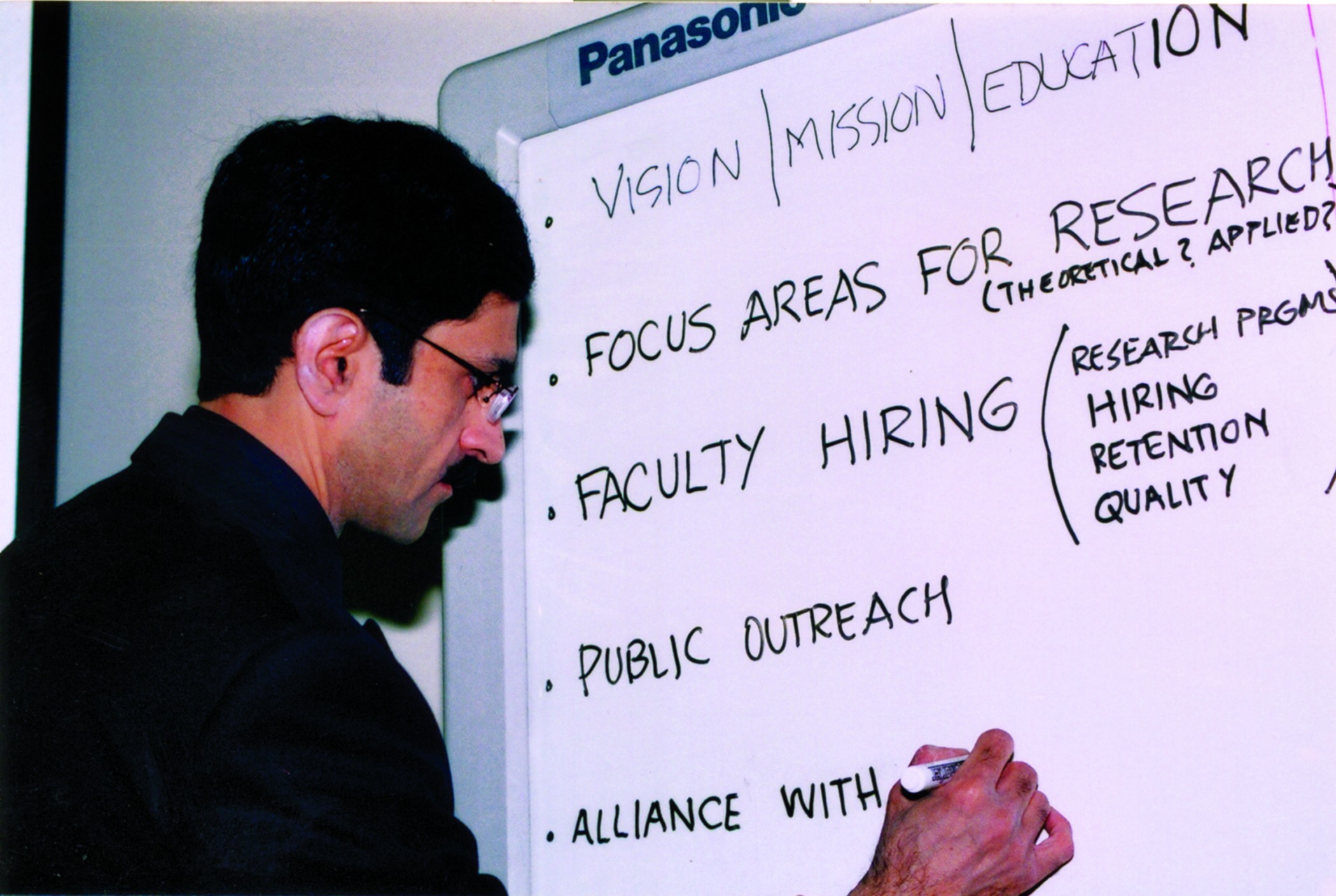
Following this presentation there was a lull in activity for a few months. Dr. Afridi returned to the United States to resume work with Techlogix Inc. and the LUMS faculty focused on their students. However, Syed Babar Ali continued to persist in building support for the new venture, now shifting his focus from seeking guidance to wooing donors. “I wrote the first cheque. That is the primary requirement for your going and asking money from others. For the School of Science and Engineering at LUMS, I wrote the first cheque for PKR 100 million.”
In April 2004, the ‘Boston group’ expanded by Bilal Zuberi, convened at MIT, with Syed Babar Ali, to discuss the report that had been presented by the LUMS Science & Engineering Initiative Team. The group members now also included representatives from fundamental sciences like Chemistry, Biology, and Physics as well as Computer Science. They felt that the LUMS study was indeed comprehensive but fell somewhat short of presenting a concrete vision for the school of science. Moreover, it was clear that to propel this initiative beyond the ideation stage, one or two dedicated people were needed who would “shape the ultimate vision of the school of science and will be the key people to turn the vision of the LUMS Management Committee into reality”.The group unanimously recommended the name of Dr. Afridi to lead the interim effort.
Dr. Afridi narrates how he received a call from his close friend Salal Humair telling him about the meeting that had taken place between Syed Babar Ali and the advisors in Boston. Dr. Humair queried whether following the preparation of the feasibility report, Khurram would be interested in remaining involved with the new venture. In Khurram’s words “…my understanding was that it would be the same level of involvement so I said ‘Yes’. To which [Salal] said, ‘Good because I already volunteered your name as the key person!"
A few weeks later, upon Syed Babar Ali’s return from the United States, a meeting took place at the LUMS Faculty Lounge where Syed Babar Ali, Khurram Afridi, Syed Zahoor Hassan, Ashraf Iqbal and other members of the Science and Engineering Initiative Team were present. After a brief discussion on the progress of the venture Syed Babar Ali turned to Dr. Afridi and said “Aap Quaid-e-Azam ki topi pehnain aur iss project ko chalaayen!” Initially, Dr. Afridi expressed his main reservations that firstly, he was not an academic, whereas a project of this kind necessitated that the lead individual be a magnet for faculty and secondly, that he was not a LUMS affiliate which may cause hurdles. It was pointed out that these were issues which could be easily resolved by involving supportive faculty and effective advisors, which was a prerequisite in any case, to take the project forward. A few weeks later, in June 2004 Dr. Afridi was formally appointed as the Project Director for the new School of Science and Engineering (SSE). He was given a room in the Vice Chancellor’s wing, adjacent to the latter’s office, and that was where the LUMS School of Science and Engineering was born.
Dr. Afridi made his first presentation on the School of Science and Engineering (SSE) to the Board of Trustees on June 5, 2004. Titled ‘From Vision to Reality’ it outlined the ambitious vision for the school, which would essentially change the model of science education in Pakistan, focusing on basic sciences and research as the foundation for quality technical education. The new school would emphasise the fundamental sciences; where engineering and Physics, Biology, Chemistry and mathematics would be taught in the same location with a strong focus on cross-disciplinary research, even at the undergraduate level.
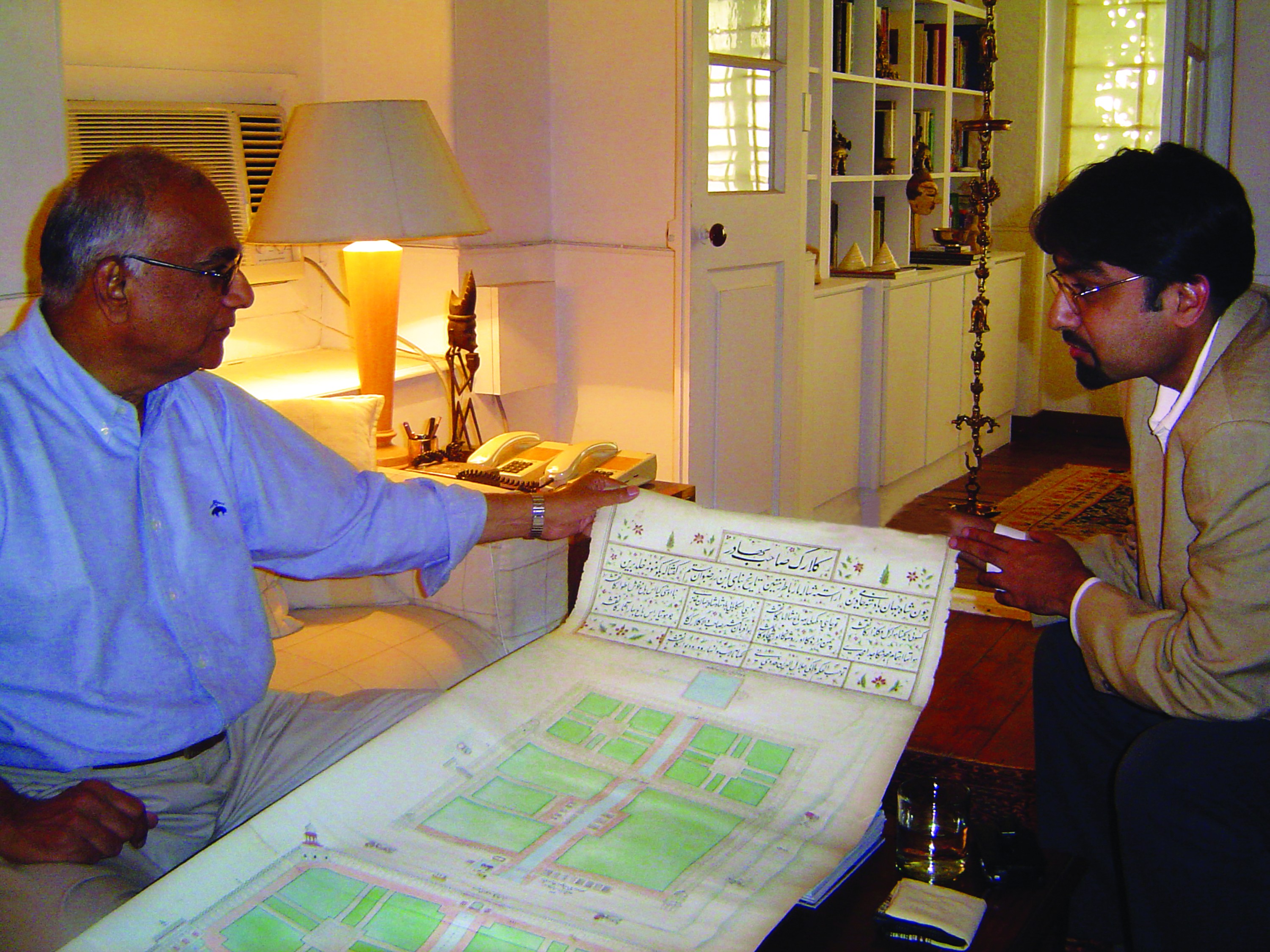
With the establishment of various roles in the venture, especially that of the Project Director, things began proceeding at an accelerated pace. One of the first activities was a meeting arranged by Syed Babar Ali, between the architect Habib Fida Ali and Khurram Afridi. The brief but consequential meeting proceeded thus: following the preliminary introductions Syed Babar Ali asked for a copy of the LUMS map. When the document was handed to him, he put his finger on the area that indicated the soccer field and declared “Iss peh cross maaren. Yeh nayay school ka plot hai.” Then he turned to Mr. Ali and Dr. Afridi and asked them to discuss the design of the building - and that was the end of the meeting.
It was Syed Babar Ali’s vision that not only provided the seed for the idea but also the roadmap on how to proceed. He initiated work on the building; he asked Dr. Afridi to meet with the advocates in Boston to devise a strategy on approaching and recruiting faculty; he charged the ‘Boston group’ with identifying academicians who would be able to advise on curriculum development; he advised Dr. Afridi and the architect to visit universities in China, Europe and the United States to gain knowledge of not only how these educational institutes are designed, but also run; and, while he galvanised others into action, he himself focused on raising money for the venture, leading the way by committing PKR100 million in June 2004. Shortly thereafter Abdul Razak Dawood and Mian Altaf Saleem both committed PKR 50 million each. Thus, the SSE quickly gained momentum.
In August 2004, the first employee of SSE, Sarah Mahmood, joined as Assistant Project Coordinator. Shortly thereafter, the SSE staff expanded to include Zakeesh Iqbal Khan as Communications Executive and a few regular volunteers including LUMS student Saima Ali (who later became the SSE Media Executive), and Shoab Malik, a freelance Graphic Designer. All these staff members shared the room with Khurram Afridi and were therefore witness to, if not direct participants in, all the activities that related to the fledgeling institute.
However, it would be unfair to state that the SSE staff members were privy to the bustle of activity by virtue of their location alone. The culture that the new school fostered was one of shared responsibility and complete transparency. There was a white-board in the SSE room upon which Sarah Mahmood, Zakeesh Khan, Saima Ali and Khurram Afridi noted their activities according to a timeline, and all updates were regularly discussed in a weekly meeting. Dr. Humair remained in contact over the phone, on a daily basis, a rather incredible feat given that a working day at SSE translated to the dead of night in Boston, USA. It was a standing joke among the staff that whenever Dr. Khurram was called out of the room in the middle of a phone conversation with Dr. Humair, the latter never hung up regardless of whether the wait extended up to 45 minutes! At which point one or the other staff members would awkwardly pick up the phone and say “Salal, are you still there? I don’t know how long Khurram will be, shall I take a message?” Invariably Dr. Humair would offer reassurance that he did not mind the wait because he was in fact working on his laptop.
Similar to the early days of the LUMS business school (subsequently renamed the Suleman Dawood School of Business), there was an incredible sense of camaraderie and ownership. Sarah Mahmood narrates, “That room is a historical room for SSE. It has a lot of good memories…but a lot of battles were also fought in that room. We were not witness to most of them but we knew when they happened…..when we would come back, we saw Khurram with his hair all flustered, his expression all tense, and we knew he had struggled for tenure-track, pushed for need blind admissions, etc.”
Amusingly, the first lesson all employees of the new school received from Dr. Afridi was ‘the correct way’ to staple documents! Sarah Mahmood smiles that he sat her down and showed her that “…you are supposed to leave this much space from the top, this much from the side and staple vertically” and she is not alone in this experience. This may certainly seem comical, but it set the tone as per the level of attention to detail, and also emphasised flawlessness. And Dr. Afridi sought perfection in all that he, along with his team, set out to do. This was evident, subsequently, in the faculty recruitment process that SSE followed, the expansive marketing campaign, the design of the SSE complex, the rigorous admissions process and even the website that was initially designed for the new school.
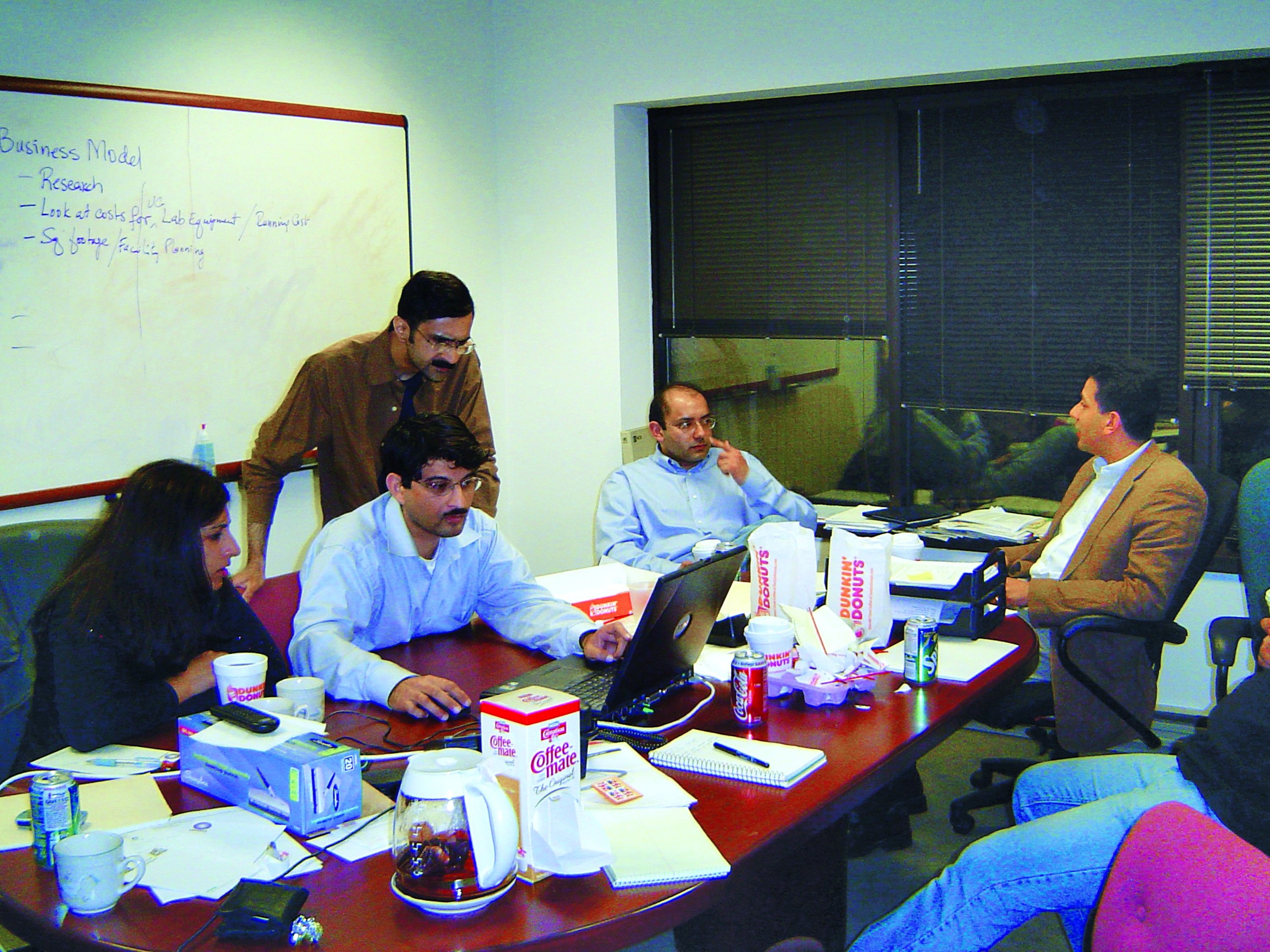
Perhaps it is not at all surprising that the championing engineers for both institutes at LUMS, Javed Hamid for the business school and Dr. Afridi for the school of science, are reminiscent of each other in their eye for detail and focus on excellence. And it is worth noting that Syed Babar Ali was largely responsible for bringing both of them on board.
Dr. Afridi’s close friend and associate, Dr. Humair led the effort from Boston, USA; and continued to do so without any official role in SSE for the first three years of its inception. He maintained close ties with the group that had interacted with Syed Babar Ali and coordinated with the academicians and corporate executives who played an invaluable advisory role for the SSE in its formative stages.
To involve more academics into the planning of SSE and to attract potential faculty members, two groups were created: a ‘Core Team’ with well-defined responsibilities, basically comprising the actively involved members of the ‘Boston group’, and a wider group of people, the ‘Virtual programme Development Team’ (VPDT) who would be regularly consulted. The members of the ‘Core Team’ including those who joined later were:
Khurram Afridi - Chief Operating Officer, Techlogix Inc.
PhD (Electrical Engineering) Massachusetts Institute of Technology
Salman Ahsan - Manager, Linear Technology Corporation
PhD (Electrical Engineering) Princeton University
Salal Humair - Senior Software Engineer, Optiant Inc.
PhD (Operations Research) Massachusetts Institute of Technology
Shahid Khan - Senior Scientist, Laboratory of Neurobiology NIH
PhD (Biology) Yale University
Asad Naqvi - Asst. Professor, University of Wales at Swansea
PhD (Physics) Massachusetts Institute of Technology
Farhan Rana - Asst. Professor, Cornell University
PhD (Electrical Engineering) Massachusetts Institute of Technology
M. Hamid Zaman - Post-Doctoral Associate, Massachusetts Institute of Technology & The Whitehead Institute
PhD (Chemistry) University of Chicago
Tasneem Zahir - Post Doctoral Fellow, Harvard Medical School
PhD (Biology) Cambridge University
Bilal Zuberi - Consultant, Boston Consulting Group
PhD (Chemistry) Massachusetts Institute of Technology
The members of the Core Team met with leading academicians as well as corporate executives to seek advice on building such an institute from scratch. The fundamental concept which resonated throughout all interactions was that unless knowledge creation was the hallmark of the institute, it would not serve the purpose of its creation. Therefore, the idea of LUMS as a ‘research university’ was born. In 2005, Syed Zahoor Hassan, LUMS Vice Chancellor, officially obtained approval from the Board of Trustees to expand the University’s vision statement to espouse this concept.
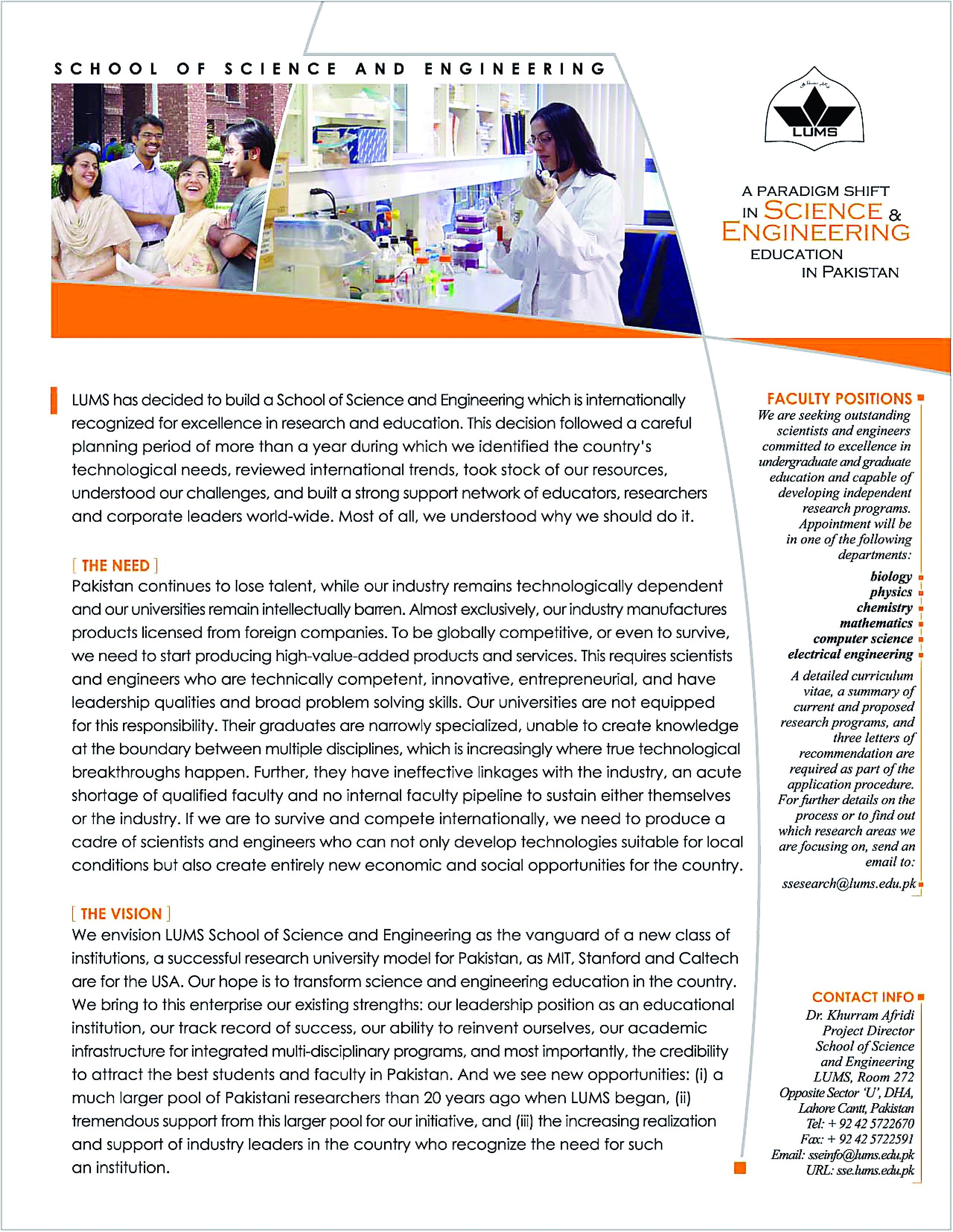
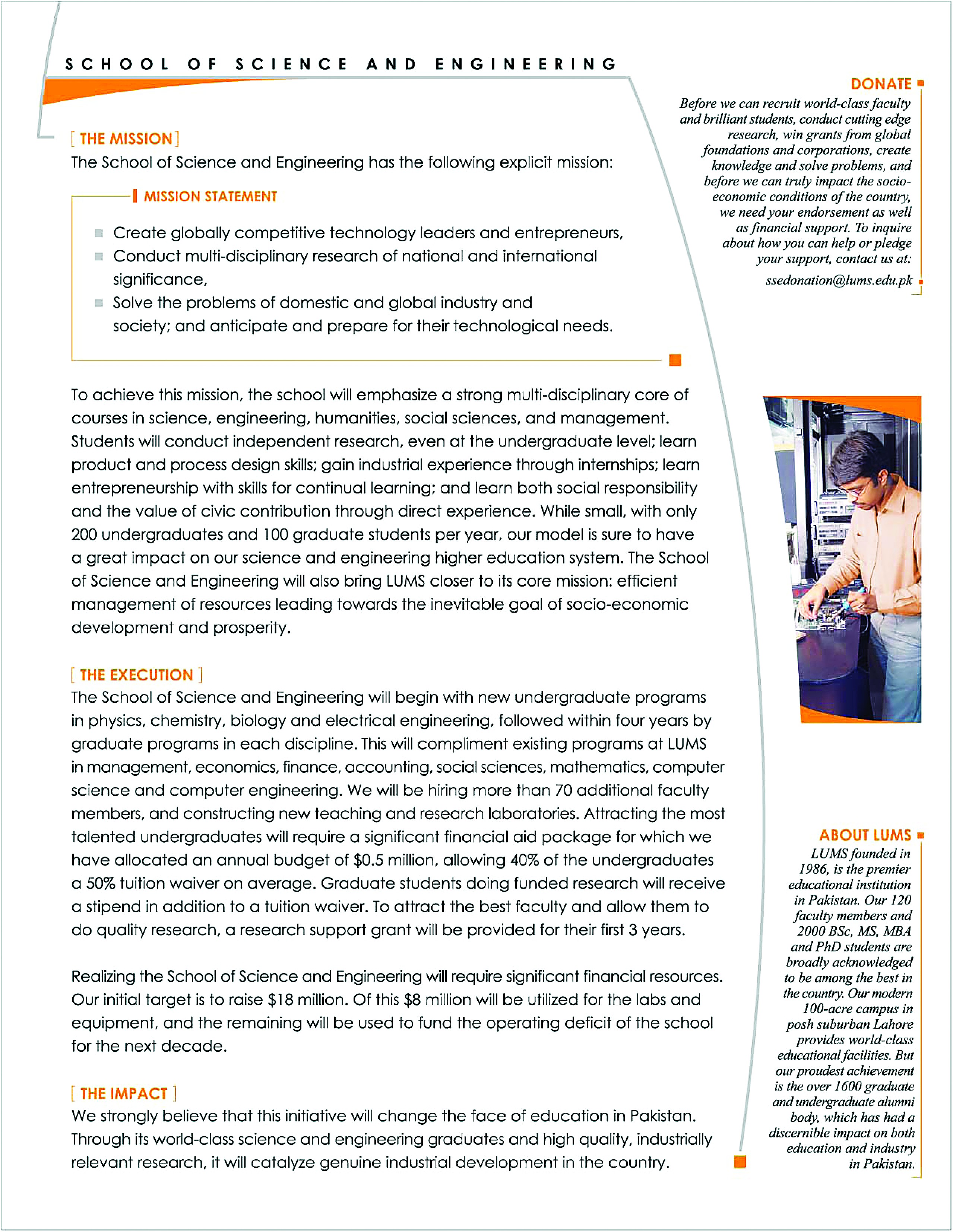
To become an internationally acclaimed research university that serves people and society through excellence in education and research, by attracting, retaining and nurturing top class intellectual talent. Knowledge creation necessitated research, and unless LUMS offered research opportunities, good faculty would not come on board. It is imperative for faculty to be intellectually challenged by each other, as they cannot be productive in individual isolation. Therefore, it was advised that LUMS should be especially flexible with visiting faculty and encourage people to come, whether for long or short periods. Moreover, it was clear that to attract research-active faculty, a tenure-track system needed to be implemented, which would serve as a self-selecting process to retain the best. In the midst of all this activity, Dr. Humair, who edited much of the early collateral, kept all the supporters of SSE continuously engaged via a newsletter titled “Science and Engineering Innovation” which provided an update on all aspects of SSE.
During the fall of 2004, Dr. Afridi and Habib Fida Ali had visited laboratories in USA at MIT, Harvard, Stanford, Caltech and Washington University in St. Louis. They also attended a conference in Boston where they met leading lab designers and got in touch with Dober, Lidsky, Craig & Associates, a leading facility programming firm, and Payette Associates, a leading architectural design firm. They obtained agreements for the validation of SSE’s facility programme and architectural plan from these firms. In the meanwhile, work had also been proceeding on the financial estimates for the new school. In September 2005, Dr. Afridi presented all his findings to the LUMS Management Committee, as well as local corporate executives who could support the venture.
Khurram Afridi, Salal Humair, Syed Zahoor Hassan, Syed Babar Ali and others convinced leading academics and corporate leaders to become involved with SSE in an advisory capacity. In parallel, the size of the VPDT continued to grow, with academics such as Dr. Nabeel Riza, Dr. Pervez Hoodbhoy, Dr. Azhar Rizvi, Dr. Fridoon Ahmad, Dr. Irfan Essa, Dr. Adil Bashir, Dr. Rizwan Gul, Dr. Avais Kamal, Dr. Umar Mahmood, Dr. Faheem Hussain, Dr. Tauseef Salma and Dr. Amer Iqbal joining.
The SSE Advisory Board
It would not be unfounded to claim that the refined vision for the School of Science and Engineering and the strategy that was followed was significantly guided by the sage advice and altruistic leadership of a number of eminent academicians and corporate executives. These individuals had been approached by various members of the SSE team and they extended their generous and unfailing support to the venture.
Dr. Hassan Ahmed (CEO of Sonus Networks) was brought on board by Atiq Raza and Khurram Afridi at a very early stage of the project. Dr. Ahmed remains associated with the SSE Advisory Board to date. His input as an experienced corporate executive and former academician has proven invaluable to the development of the SSE vision and its research strategy. He was also an integral part of the SSE dean search process.
Dr. John Kassakian (Prof. of Electrical Engineering, MIT), who had been Khurram Afridi’s doctoral advisor, also agreed to join the advisory board. Dr. Kassakian played an important role in the first dean search and helped formulate the vision that the SSE was hoping to achieve.
Similarly, Dr. Richard Larson (Mitsui Prof. of Engineering Systems, MIT) was Salal Humair’s PhD advisor. Dr. Larson remains passionately associated with the SSE Advisory Board and was the creator of the SSE credo of “No Boundaries”. About his association with SSE, Dr. Larson states, “When this activity was put forward to me it seemed to be totally compatible with my belief that …education is the most important investment mankind can make… you start with a dream and nothing, and then a piece of paper and then all of a sudden we have all this!” Dr. Larson was the second chair of the advisory board.
Syed Zahoor Hassan and Khurram Afridi convinced Dr. Khalid Aziz (Otto N. Miller Professor Emeritus, Stanford University) to contribute to SSE. Dr. Aziz was also the first tenured professor at SSE, with a joint appointment at Stanford University. During the first Advisory Board meeting in 2005, Syed Babar Ali approached Dr. Khalid Aziz and queried how LUMS could compensate the distinguished academics and leaders who were giving so generously of their time to the new school. Dr. Khalid Aziz smiled, shook his head and replied, “You cannot buy them….None of the people who are involved in the SSE project expect to be paid for it!”
Dr. Stephen Berry (James Franck Distinguished Service Prof. Emeritus, University of Chicago) was brought on board by M. Hamid Zaman who was a member of the core team. Dr. Berry thought that “academically, it was a wonderful challenge….quite frankly, I was also intrigued when I realised the composition of the committee, the fact that there were members from India…and a number of the members were Jewish”. At the outset, Chemistry was the one discipline that was proving the most challenging as far as faculty recruitment was concerned, and since not much expertise was available on the ground, Dr. Berry’s input in the curriculum design was pivotal.
Similarly, Asad Naqvi, also a member of the core team, persuaded Dr. Robert Jaffe (Jane and Otto Morningstar Prof. of Physics, MIT) to meet with a group of LUMS representatives which included Syed Babar Ali. Interestingly, after the meeting Dr. Jaffe contacted his principal connection in Pakistan, Dr. Pervez Hoodbhoy (Prof. Quaid-e-Azam University) and queried about Syed Babar Ali’s credibility before committing to the project. Dr. Jaffe’s contributions cannot be overstated; he was the first chair of the advisory board and the initiator of the Abdus Salam Chair at SSE.
Syed Babar Ali won over Dr. Hubertus Dewitz (Head, Siemens Corporate Technology, Central Research & Development). He and Dr. Humair convinced Dr. Ashok Mittal (Prof. of Industrial and Management Engineering, Indian Institute of Technology, Kanpur). Dr. Mittal’s advice and guidance was invaluable; his association with the Indian Institute of Technology allowed SSE to learn from a success story in an environs very similar to Pakistan. Moreover, he generously shared programme and syllabus documents which helped benchmark the SSE curriculum.
Other prominent members of the board included Mir Imran (founder and Chairman of InCube Laboratories, Inc. USA) and Dr. Obaid Siddiqui (Tata Institute of Fundamental Research, India). These learned scholars very charitably lent their experience and time to SSE on a pro-bono basis. They were deeply involved at all stages of development, from the refinement of the school’s vision to the Dean’s search, from faculty recruitment to curriculum development. The SSE credo of ‘No Boundaries’ recommended by Dr. Richard Larson, applied not only to the intake of students, but also clarified the tenet of cross-disciplinary and collaborative research, which SSE, as well as LUMS as a research university, was aiming to foster. They also vigorously supported the concept that a strong base in fundamental sciences was essential to developing undergraduates who would be problem solvers and knowledge creators. The participation of these global leaders served to project LUMS internationally, at a significant scale, for the first time.
Progress
The years 2002 to 2004 witnessed the eveloution of the LUMS School of Science and Engineering from a mere idea to a tangible project. the groundwork for the new school started in 2004 and accelerated in 2005 and 2006.
The first public event relating to the new school of science and engineering was a workshop held at LUMS on January 2-3, 2005. This was the first time that LUMS introduced its new undertaking to the local industry and academia. The 68 participants included LUMS affiliates, local business representatives, leading academicians (foreign as well as local), and also some members of the Virtual Program Development Team. The aim was to collectively brainstorm on the challenges that needed to be overcome for SSE to be brought to fruition.
There was much debate and disagreement on SSE’s potential emphasis upon basic research and science without foreseeable commercial benefits. Eventually, a consensus emerged that a balance was needed between basic and applied research and that the long-term vision of the school must include both. Industry representatives also stressed Pakistan’s need for cross-disciplinary education and product oriented research. Focus groups were conducted to evolve strategies for faculty hiring and retention, resource mobilisation and funding, and research and industrial collaborations. It may be interesting to note that, similar to the launch of the LUMS business school, there was intense idealism in the SSE project team. For example, there was unanimity on the decision that the initial faculty needed to be exceptional to set the standard for the new institute. Also the “the biggest competitive advantage of SSE was consensually seen to be the ‘sense of achievement’ derived from being part of an opportunity to make history.”
Subsequent to the workshop, a number of concrete developments took place. The Appointment Promotion and Tenure Committee was set up to develop a policy for tenure-track hiring and to devise a process for the transition of the existing faculty at LUMS, which was employed under a contract system. Arif Zaman, Prof. of mathematics at LUMS, and Irfan Essa, member of the Virtual Programme Development Team, were the co-chairs of the committee. Sohaib Khan, Computer Science faculty at LUMS, worked on the admission criteria for SSE. He examined the existing admissions process at LUMS and the data that top US universities required. Sarah Mahmood (Asst. Project Coordinator), Zakeesh Khan (Communications Executive) and Shoa Malik (Graphic Designer) set about developing material for the website as well as collateral for fundraising. They worked in close collaboration with Salal Humair, who in turn, kept the core team closely involved.
In the meantime, the Infrastructure Committee was also set up, comprising Azmatullah Khan (Chair - Director, Facilities and Engineering), Hanif Rajput (Director, National Management Foundation) and Khurram Afridi, to oversee the design and construction of the building. Azmatullah Khan was the overall in-charge of the construction. Habib Fida Ali drew up the architectural schematics based on the facilities programme developed by Dober, Lidsky, Craig & Associates. The earlier LUMS buildings designed by Habib Fida Ali had an ‘old Lahore’ feel to them, but a science and engineering building had different requirements, e.g., the layout had to accommodate services such as pipes for vacuum, nitrogen gas, etc., the air-conditioning in the Chemistry and Biology areas had to be ‘once through’ wherein circulated air is replaced with fresh air constantly, to protect occupants against germs and noxious gases.
The SSE complex master plan comprised three buildings (H-shaped), totalling 550,000 sqft., to be developed in two phases. The first phase would include the construction of two connected (300,000sqft) six-storey buildings with highly specialised central labs in their basements. The remaining floors of the larger building were divided The summer of 2005 witnessed the first SSE Advisory Board Meeting; a gathering which would subsequently become a regular feature of the school, following the precedent set by the LUMS business school of seeking counsel from leading academicians.
This landmark meeting took place on July 25-26, 2005 at the MIT Endicott House in Dedham, Massachusetts, USA. The members of the Advisory Board who attended were:
Dr. Hassan Ahmed
CEO of Sonus Networks
Dr. Khalid Aziz
Otto N. Miller Professor Emeritus, Stanford University
Dr. John Kassakian
Prof. of Electrical Engineering, MIT
Dr. Richard Larson
Mitsui Prof. of Engineering Systems, MIT
Mir Imran
Chairman, InCube Laboratories, Inc.
(attended via phone)
Syed Babar Ali, Khurram Afridi, Salal Humair, Asad Naqvi, Farhan Rana, Tasneem Zahir, Bilal Zuberi, Hamid Zaman, Tauseef Salma, Ayman Shabra and Salman Ahsan, were also in attendance.
It was at this meeting that Dr. Richard Larson came up with the concept of “No Boundaries” which became the slogan for SSE in years to come. He clarified that he had initially discussed this idea with Salal Humair, who had been his doctoral student and the individual who had convinced him to come on board, before presenting it to the rest of the advisory members. Dr. Larson stated his reasoning as, “Since I have been in academia all my adult life, I have seen the advantages and limitations of academic silos…and for a transformative place like SSE, you don’t want to be limited to the academic silos which go back centuries in academia. You want to configure things so that people can work together, use their discipline based knowledge in cross-disciplinary teams to try and attack the major problems of society…and I believe that education is the most important investment mankind can make. Every child should have an equal opportunity for education, regardless of their place of birth or the wealth of their parents.”
among the majors, and housed their labs and offices. The top floor was ear-marked for Chemistry, to help minimise the cost of the air handling ducts for fume hoods. Since Biology had close synergies with Chemistry, it was planned for the floor below. Faisal Haroon, Managing Partner at Haroon & Haroon, started designing the interior and furniture in consultation with Khurram Afridi, and under the guidance of Arlen Li, a lab design specialist at Payette Associates in Boston. Arlen Li was involved to ensure that SSE labs would be safe for the users as well as the other occupants of the building.
Much debate occurred on the inspiring and idealistic concept of ‘No Boundaries’, and quite a few argued that it could not be implemented owing to administrative restrictions. It was clear that if a balance was not struck, SSE would lose its objective of over-reaching impact as it would fail in the “tradeoff between the excellence that comes from focus and the impact that comes from breadth”. In the end, consensus emerged that the administrative structure should have departments, but the research areas would be cross-cutting across these departments. As far as possible, SSE would have common labs that are used by scientists and engineers. This structure would be along the lines of the ‘matrix’ structure that MIT utilises. And the ‘No Boundaries’ credo would be the unifying umbrella targeting the objectives that SSE sought to serve in the long and short term. The participants spent the two days refining the SSE vision, as well as discussing operational matters like the process for faculty recruitment, outlining the academic structure, financial planning and Dean selection. It was decided that the proposed undergraduate programme would seek to develop students who would be well versed in the basic sciences: Biology, Chemistry, Mathematics and Physics; and possess a passion for learning.
“These are the pillars. Science changes very slowly, technology keeps on changing all the time.” The aim was that a large number of the graduates would pursue higher education, culminating in knowledge creation for their community and country. It was also stated that the Advisory Board would meet bi-annually, one meeting would take place in the United States and the other one in Lahore, Pakistan. The next Advisory Board meeting was scheduled for February 16-17, 2006 in Lahore.
One of the biggest challenges in setting up the School of Science and Engineering was resource mobilisation for both, capital expenditure and running expenditure. Syed Babar Ali took this task upon himself. He not only contributed personally, but was also pivotal in raising funds from companies that he was associated with, namely Nestle, Tetra Pak, IGI, Tri-Pack Films, Coca-Cola, Bayer A.G., Siemens A.G., and Mitsubishi Corporation. In addition, he was able to persuade the Government of Punjab to make a substantial donation of PKR 500 million, Sui Northern Gas Pipelines Limited also contributed PKR 100 million, in 2008, for this nation building effort.
Before the building design was completed the fundraising target for the first phase of SSE was a daunting USD 25 million. Encouragingly, commitments for a total of $9.1 million had been received, all from within Pakistan. This level of fundraising was unprecedented in the history of LUMS. Once the building was fully designed, the target was raised to US$50 million.
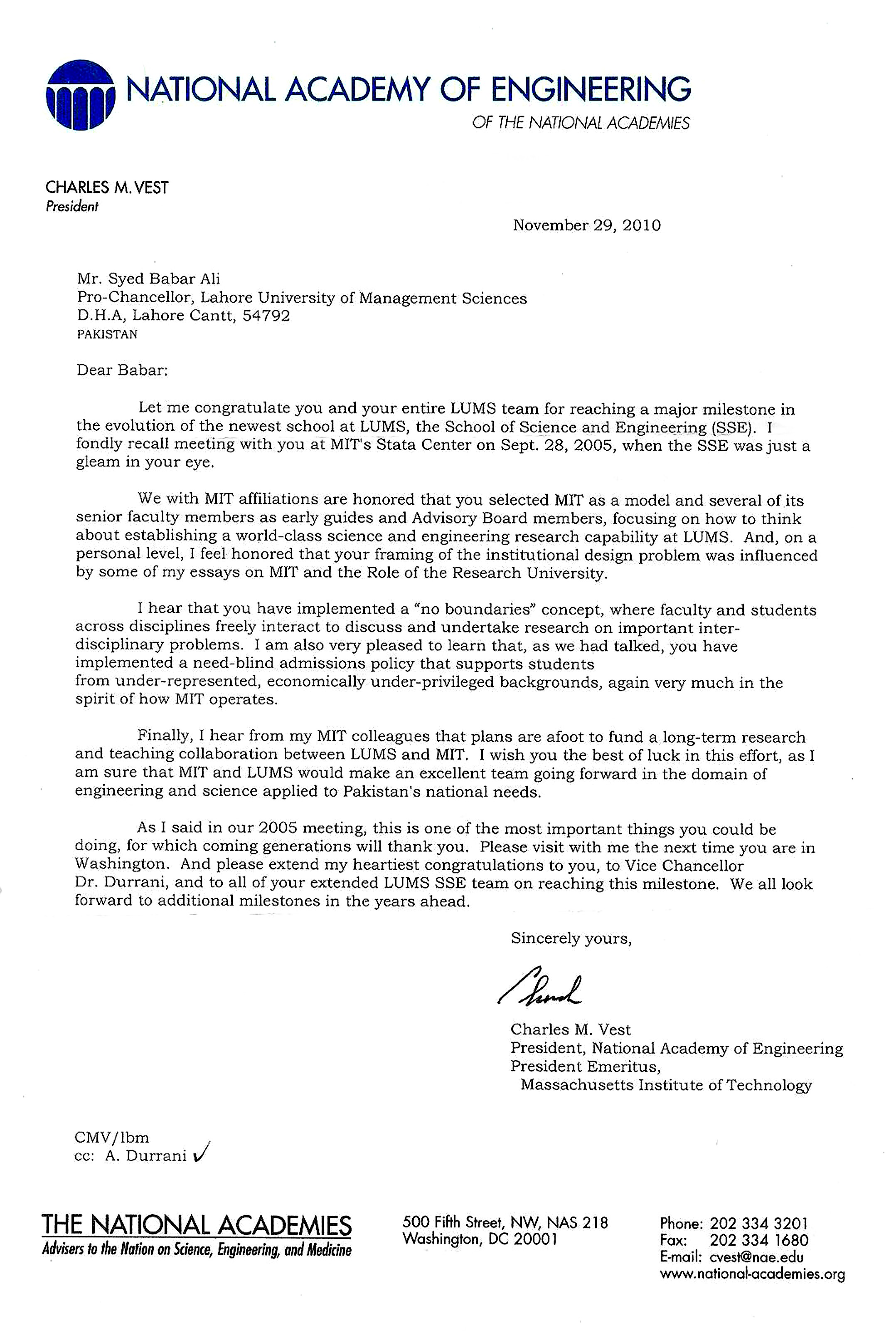
The morning of September 28, 2005 marked a momentous meeting that took place between Syed Babar Ali and Prof. Charles M. Vest, President of the Massachusetts Institute of Technology, Boston. Syed Babar Ali had proposed such a meeting for two reasons; firstly, what better way of seeking guidance than to meet the leader of the institute that the new school would be modelled after and, secondly, the exchange would, in a way, provide endorsement for the ambitious venture that was embarked on. The meeting was arranged by Salal Humair, who was the third person in attendance.
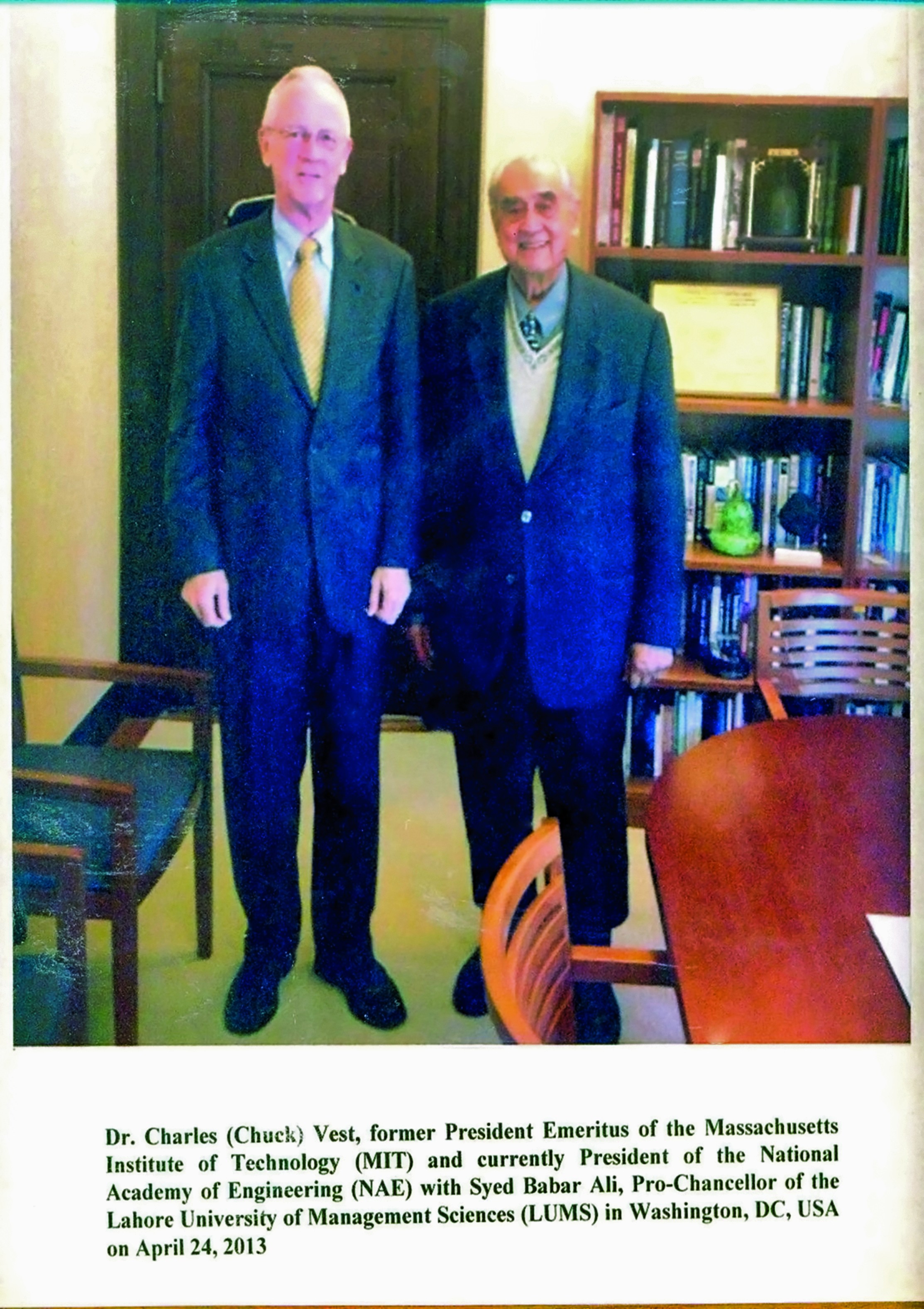
The half an hour meeting started with Syed Babar Ali giving Prof. Vest an overview of LUMS. He talked about the survey that had been conducted and the realisation that LUMS could play a role in advancing Pakistan because “we are teaching yesterday’s science.” Prof. Vest was encouraging about the venture and said that this was one of the most important things that could be done.
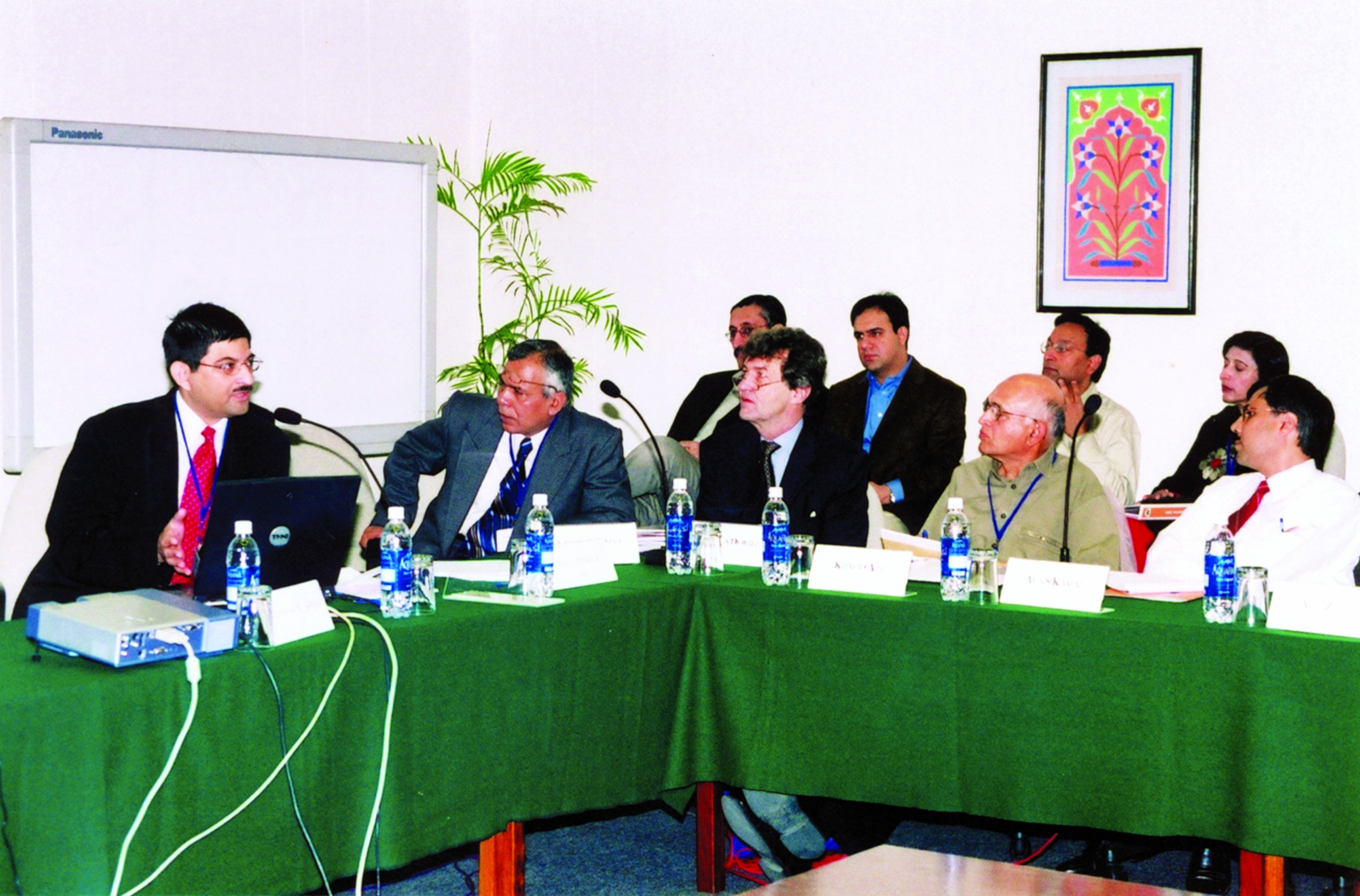
He queried about the potential students, their process of selection, the funding for the new school and the competitive landscape. He expressed encouragement for scholarships and was greatly appreciative of the National Outreach Programme that LUMS had implemented. When Dr. Humair brought up that MIT was being considered as a model for the LUMS School of Science and Engineering, Prof. Vest advised that they should consider the Indian Institutes of Technology since they were also modelled after MIT and were operational in an environment similar to Pakistan. He further advised that “….you realise you are teaching yesterday’s science but what tomorrow’s science is must come from your own unique circumstance,” i.e. the new school may look to MIT for the process but must develop the content themselves.
By November 2005, Syed Zahoor Hassan, LUMS Vice Chancellor, had directed that the existing Mathematics and Computer Science departments would be inherited by the School of Science and Engineering, in addition to the new programmes offered in Physics, Chemistry, Biology and Electrical Engineering.
In the same month, the Dean Search Committee for SSE had also been set up. It comprised the Pro Chancellor, Vice Chancellor, the Deans of LUMS and five members of the Advisory Board. Khuram Afridi was its secretary. The first advertisement for the Dean for SSE was placed in local newspapers on December 25, 2005. Although no concrete decision had yet been taken on when the first batch would be inducted, faculty recruitment was well underway and 45 applications had been processed, without the placement of a faculty ad. The first faculty member for SSE was from this pool. Faheem Hussain (PhD Physics, Imperial College, London, U.K.) joined full time in May 2006. the first tenure-track faculty position advertisements appeared in the newspapers (Dawn and The News) on April 9, 2006.
At the second Advisory Board meeting in February 2006 Syed Babar Ali summarised that the purpose of the gathering was to “add matter and thought to the dream and wish that we have embarked upon so that we are able to come up with a plan which will guide us ….we are here to listen and learn from you!” The two days (February 16-17, 2006) of deliberation focused on the potential research areas for SSE, fundraising mechanisms, guidelines for the curriculum, Dean’s search and faculty recruitment strategies. The discussion also focused on the reform that was needed, namely implementation of the tenure-track hiring system. The necessity of striking a balance between the alienation versus inspiration of the existing faculty was stressed, especially those in the Computer Science and Mathematics departments who would be inherited by SSE. Moreover, there were members of the Management Committee who opined that although SSE sought to create students well versed in the basic sciences, it should maintain focus on the local industry and create people who would support the long term, economic growth of the country.
The groundbreaking for the new SSE building took place on March 17, 2006 and construction was started. Abdul Razak Dawood, the Rector, Syed Babar Ali, the Pro-Chancellor, Shahid Hussain, member of the Management Committee and various faculty and administrative staff of LUMS attended the ceremony. The first phase which would cover 300,000 sq ft was planned as a six-storey state of the art building. It may easily be claimed that no similar building had been designed in Pakistan.
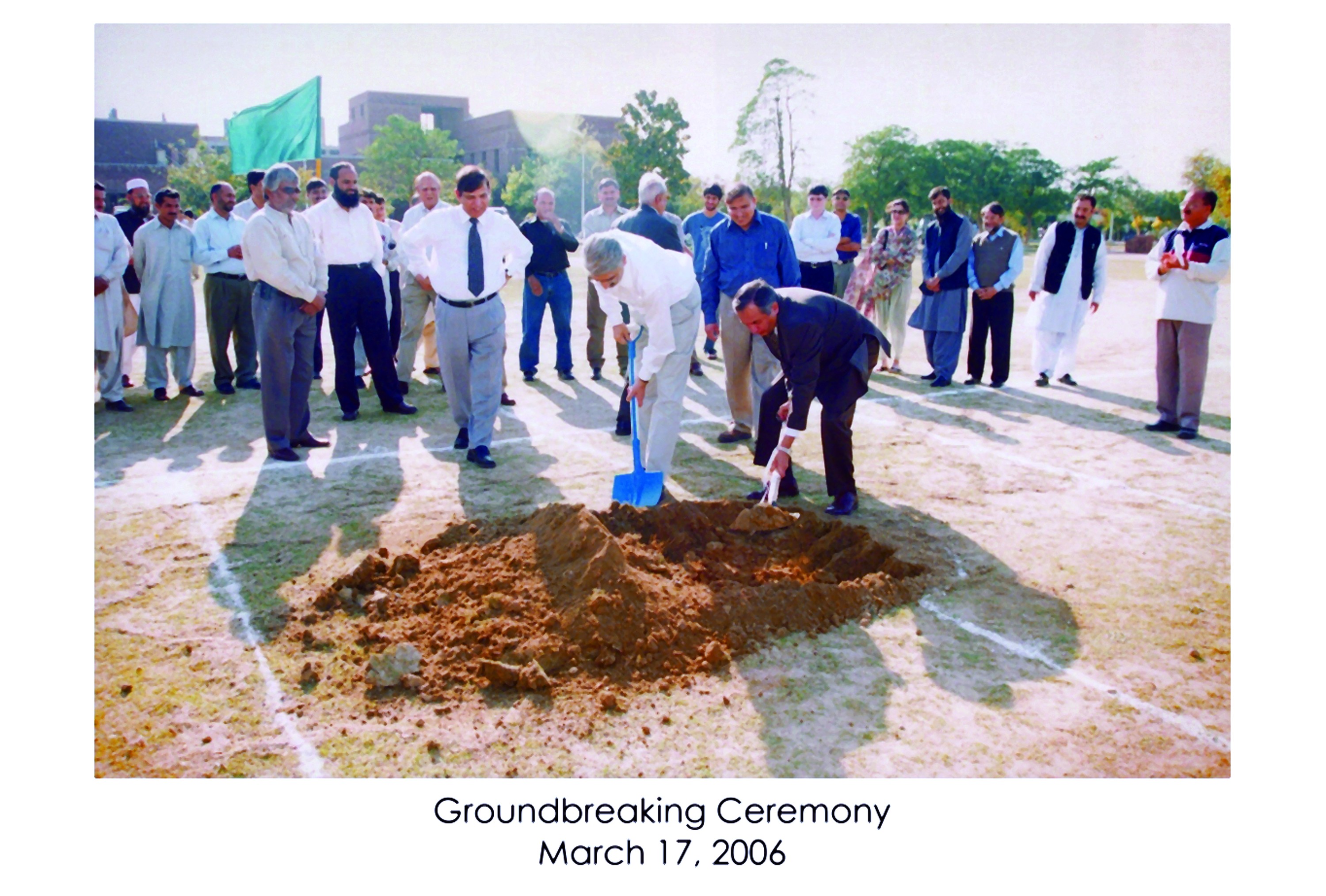
In June 2006, on the occasion of Syed Babar Ali’s 80th birthday, the Rausing family once again stepped forward and donated 5 million Euros to SSE via the Tetra Laval group of companies. After USAID, the Rausing family has been the largest donor to LUMS. They donated US$2 million to set up the Rausing Executive Centre; then they contributed US$1 million for the library, followed by this generous donation to SSE.
During the summer of 2004, while in the United States visiting laboratories and science educational institutes, Dr. Afridi had briefly met with Asad Abidi on the recommendation of Farhan Rana. Asad Abidi was an eminent scholar, an IEEE Fellow and held the honour of being a member of the prestigious National Academy of Engineering, the highest professional lifetime distinction accorded to American engineers. Khurram Afridi dropped by Asad Abidi’s office at the University of California in Los Angeles, but due to some coordination hitch Asad Abidi was unable to arrive until quite a few hours later. Consequently, he invited Dr. Afridi to dinner at his house the same night. The evening turned out to be a large family event, which took Khurram Afridi by surprise but he was quite overwhelmed by the hospitality. He talked about the new school being set up and ventured that someone of Asad Abidi’s stature would be ideal at the helm of such an institute. However, Asad Abidi’s wife explained that although he would be glad to contribute, full time involvement and relocation was quite out of the question. Upon his return, Dr. Afridi mentioned his meeting to Syed Babar Ali, who advised not to worry about the Dean at that point, as there was much to be done. Therefore, it is interesting that by May 2006, when the Dean search was in full swing, the three shortlisted candidates out of the fifty potential ones, included Asad Abidi.
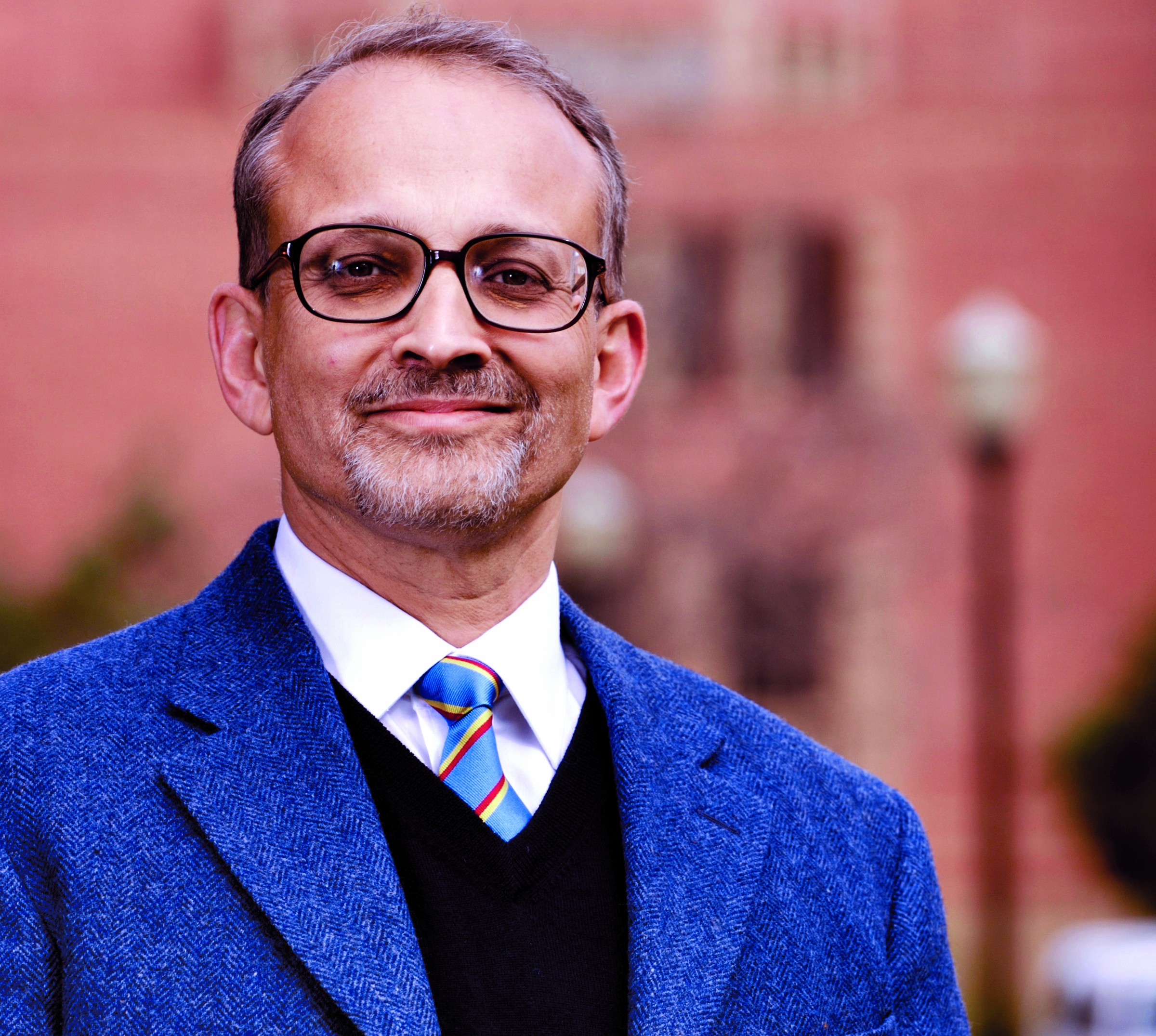
Members of the SSE Advisory Board played a significant role in the first dean search. Dr. Stephen Berry, Dr. Hassan Ahmed, Dr. Khalid Aziz and Dr. Robert Jaffe not only helped to identify and evaluate candidates, but even contributed to the minutiae of the process by defining questions for the interview and identifying factors that merited attention in the evaluation process. The shortlisted candidates also met with the search committee members based in the United States. Subsequently, references were sought from former students and colleagues. Finally, they were invited to visit the LUMS campus and meet with faculty and staff. After this rigorous process, Asad Abidi (PhD, Electrical Engineering, UC Berkeley) accepted the position of the first Dean of SSE and agreed to come on board from September 2007.
In September 2006, Dr. Khalid Aziz, member of the SSE Advisory Board and Otto N. Miller Professor Emeritus, Stanford University accepted joint professorship at SSE. Dr. Aziz generously promised his time to the newly set up institute and his name lent significant weight to the fledgling faculty portfolio of SSE. A month later, Asad Naqvi, who was already actively involved in setting up the SSE as a member of the ‘core team’ was offered the first tenure-track faculty position as an Associate Professor of Physics.
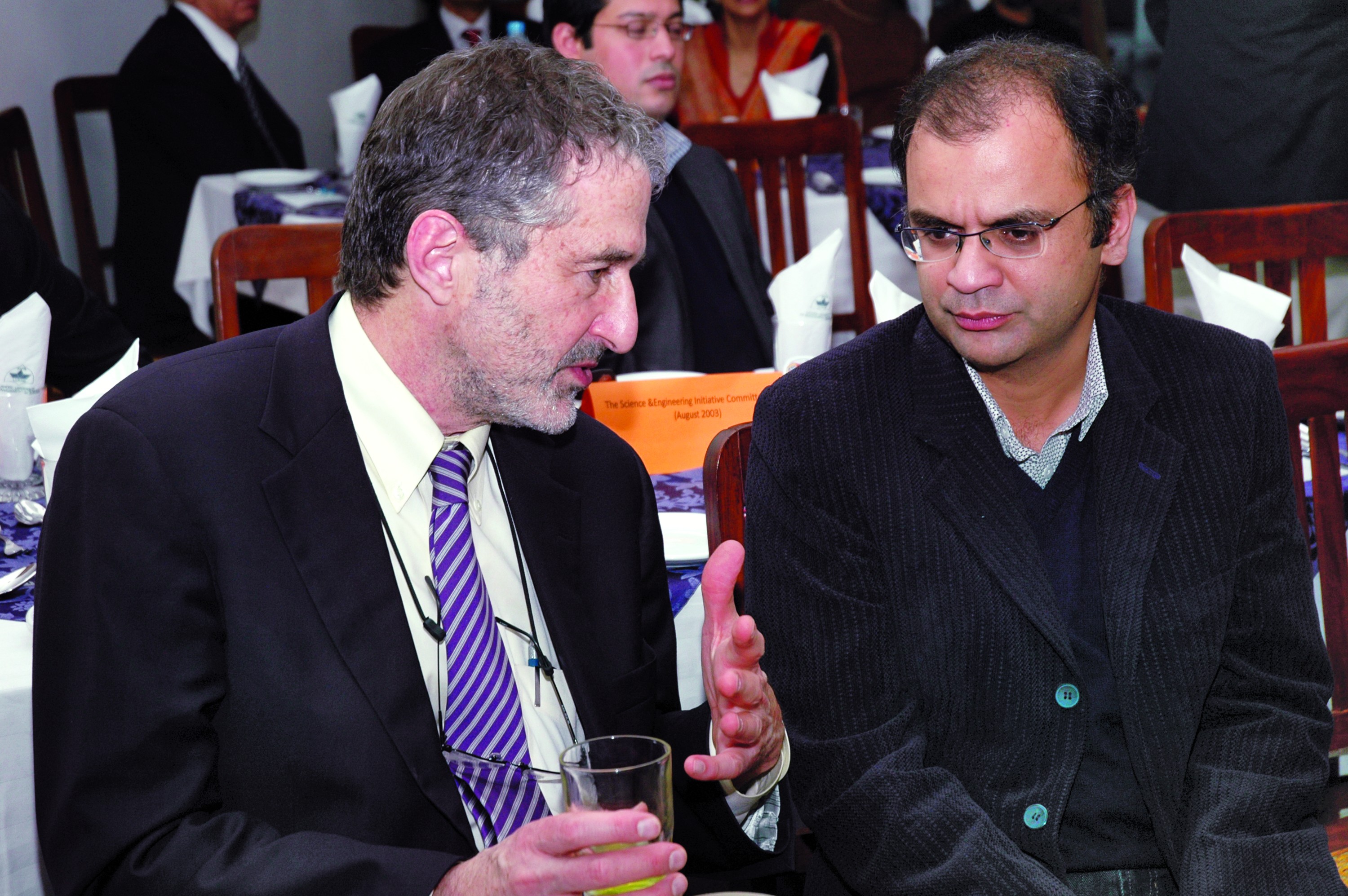
The first two endowed chairs at the SSE were approved on December 18, 2006; the first was the Ahmed Dawood Chair for the Dean of SSE, which was gifted by Hussain Dawood, for US$2 million, in memory of his father. It is particularly admirable that Hussain Dawood supported SSE, given that he was completely involved in and committed to the establishment of the Karachi School of Business and Leadership.
The second was the Abdus Salam Chair, the idea for which was put forward by Dr. Robert Jaffe, chair of the SSE Advisory Board. It was decided that the Abdus Salam Chair would be a school-wide chair, not a departmental one, since Dr. Abdus Salam was not merely a Pakistani Nobel Prize Winner but among the cream of Nobel Laureates. His work on the unification of electromagnetic and weak forces remains one of the two major achievements of fundamental physics since quantum mechanics, the other being quantum chromo dynamics. This chair is especially significant because LUMS chose to honour a national hero in the face of prejudiced politics and bigoted laws. Dr. Jaffe stated that naming a chair after Dr. Abdus Salam seemed to be “the easiest decision you could possibly make!” and explained his motivation as “To have so many aspiring young students in Pakistan and yet to have their greatest scientist of the twentieth century..…not celebrated as a symbol of the country? It seemed to be exactly the kind of idea that ‘No Boundaries’ was meant to overcome.”
Growth (2007-2008)
By 2007, things were proceeding at an accelerated pace and there was exciting progress on various fronts. The first Dean for the LUMS School of Science and Engineering, Asad Abidi, had been selected and was scheduled to arrive by the summer. Dr. Abidi had in fact conducted the first open course to be offered by SSE in July 2006. It was a two week course on Analog and Mixed Signal Integrated Circuit Design.
The SSE complex was under construction and expected to be functional by the summer of 2008. The reinforced concrete structure was being worked upon by 130 construction workers of Mughal Imperial who lived on site. This structure was designed by progressive Consultants, with guidance from M. Afzal Cheema of Walter P. Moore, who donated his time free of charge. April 2007 to August 2008 was a time fraught with frantic activity. Khurram Afridi, Azmatullah Khan and a handful of faculty members were deeply involved in assessing needs, ordering equipment and chemicals and working out innumerable details for the design of the labs, offices and facilities. There seemed to be no end to the planning meetings between Khurram Afridi, Azmatullah Khan and the air-conditioning and ducting contractors, and furniture vendors, and Habib Fida Ali’s representatives and Faisal Haroon for review of the blueprints.

By the end of 2006, donation commitments for the new school had crossed the US$29 million mark and therefore the target had been raised from US$50 million to US$125 million. In view of this bold objective, Syed Babar Ali recommended that a dedicated Development Office be set up for SSE, which could identify potential donors and open doors for SSE. Salal Humair and Sarah Mahmood, previously the Asst. Project Coordinator, were designated to take up this challenge. The Development Committee for the new school comprised largely of ‘young blood’ from some of the local, influential business families including Raza Mansha, Shahzada Dawood, Syed Maratib Ali and Arif Farooq. The team at SSE worked in coordination with the committee to formulate a resonant and convincing strategy, identify potential donors and develop suitable collateral. As expected, Syed Babar Ali remained closely involved in all stages, offering not just advice and the credibility of his name, but also tangible support wherever needed.
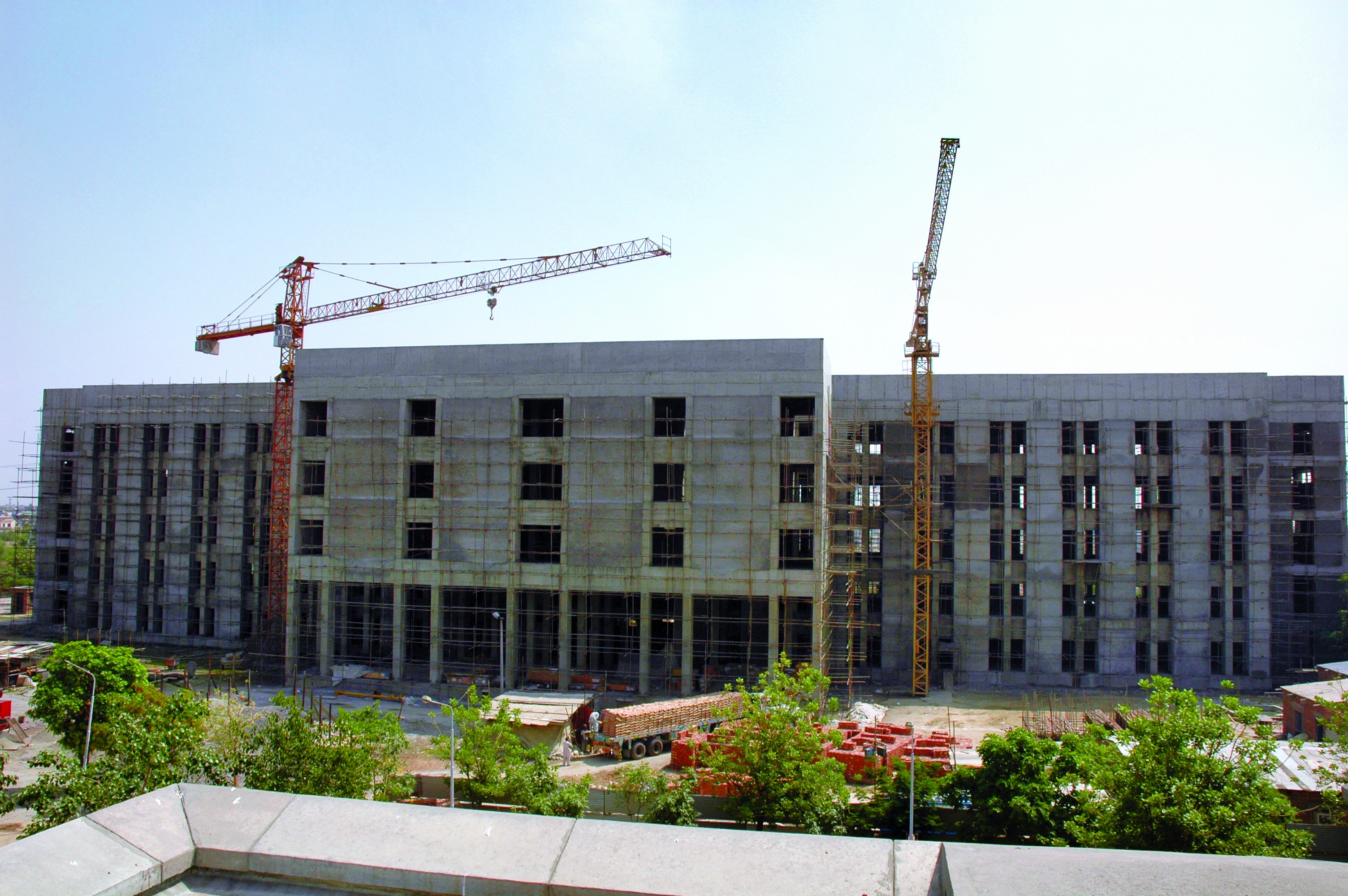
In September 2007, the second largest organisational donation to SSE was made by Dr. Klaus Wucherer, Director Siemens, for 1 million Euros. Syed Babar Ali remains the largest individual donor to date.
On January 18, 2007 a few LUMS and SSE representatives met with Gen. Pervez Musharraf, the President of Pakistan, at the National Security Council Secretariat. The participants included members of the SSE Advisory Board: Dr. Khalid Aziz, Dr. Stephen Berry, Dr. Hubertus Dewitz, Dr. Robert Jaffe, Dr. Richard Larson and Dr. Amos Nur, as well as Abdul Razak Dawood, Syed Babar Ali, Syed Zahoor Hassan, Khurram Afridi and Salal Humair. Syed Babar Ali had requested this meeting with the President, who was also the Chancellor of LUMS, not just to introduce the new school that was being launched, but also to present options which may “impact the larger higher education landscape in the country.”
Dr. Robert Jaffe made a brief presentation to the President clarifying the importance of the LUMS School of Science and Engineering not just as a game-changer in the arena of science education in Pakistan, but also from the point of view of the external academic community. Dr. Jaffe mentioned the Indian mathematician Srinivasa Ramanujan (1887–1920), a poor peasant who used to work on the floor of his house, and was discovered when he was not even 25. Ramanujan is one of the most eminent mathematicians of the twentieth century, and Dr. Jaffe argued that “….the ancient tradition of being interested in science and mathematics is part of Pakistan’s deep intellectual tradition, and we felt there were people all over, in every economic class, who were capable of that kind of achievement and hoped that SSE would be the conduit to bring them into the world.” This argument resonated with Gen. Pervez Musharraf and he strongly encouraged the undertaking. Prof. Atta-ur-Rahman, the Chairman of the Higher Education Commission (HEC) of Pakistan joined the meeting as well. This may have been significant, because the HEC offered grants to public universities but private institutes were not eligible to receive money. However, later in the year, HEC did agree to entertain a proposal from SSE, which was a first. The PKR 1.5 billion proposal, developed by Khurram Afridi and Salal Humair, with input from other faculty members, and supported by Dean Asad Abidi, got approved in April 2008.

In the summer of 2007, SSE moved its office out of the one room in the Vice Chancellor’s wing to the second floor above the LUMS Pepsi Dining Centre. Initially, the floor was rather empty. The SSE staff sat together once again, as in the room on the Vice Chancellor’s wing; Sabieh Anwar and Khalid Rasheed were the only other two full-time faculty members occupying rooms - but it was not very long before the whole floor was buzzing with more occupants than could be comfortably managed! Salal Humair relocated from Boston, USA to Lahore to carry his commitment through. To streamline the faculty hiring process, Kiran Anwar had joined SSE as the Human Resource and Faculty Recruitment Executive. Her task was a coordination juggling act because SSE faculty applications were vetted by not just by the team on the ground, but also by various stakeholders across the globe, which included the Advisory Board, referees and academic associates. By mid 2007, there were six tenure-track faculty members on board: Sabieh Anwar, Tasneem Zehra Husain and Asad Naqvi (Physics), Salal Humair (Engineering Systems and Operations Research), Hassna Ramay and Shahid Khan (Biology). Asad Abidi and Khalid Aziz were tenured joint faculty with University of California at Los Angeles and Stanford University respectively. There were also a number of visiting faculty who were engaged. Thus far, Chemistry had proven the most challenging major to recruit for but with Khalid Rasheed, (PhD Chemistry, University of Heidelberg, Germany) agreeing to come on board full-time this apprehension was eased.
It had been decided that the four-year degree that the new school offered would be called Bachelors of Science (BS). An independent admission stream for SSE was deemed necessary owing to a number of factors; the strongest argument being that the type of students SSE was hoping to attract were a specific breed: not merely those who had done academically well, which was a pre-requisite, but those who had a strong passion for science itself. To identify such students necessitated a process which would focus on aspects in addition to academic excellence, and also allow the student room to reveal other facets of his or her personality. Moreover, the new school aimed to cast a wide net so that the intake would include not only applicants from far flung areas, but also a significant number from the local educational stream, in addition to the GCSE O’/A’ Levels students who were the established market for LUMS. Then there was the practical consideration that SSE students would declare their major choice at the end of the first year, instead of at the time of admission as was the case with the LUMS undergraduate body. Thus, a separate admissions process for SSE was given the go-ahead.
The first SSE undergraduate batch was to start classes in 2008. Hence, course development went into full swing by late 2007. All faculty on the ground were deeply involved. The core curriculum had been designed and the focus now shifted to major requirements and electives. The incoming students would undergo rigorous freshman and sophomore years with core requirements that included Mathematics, Physics, Chemistry and Biology.
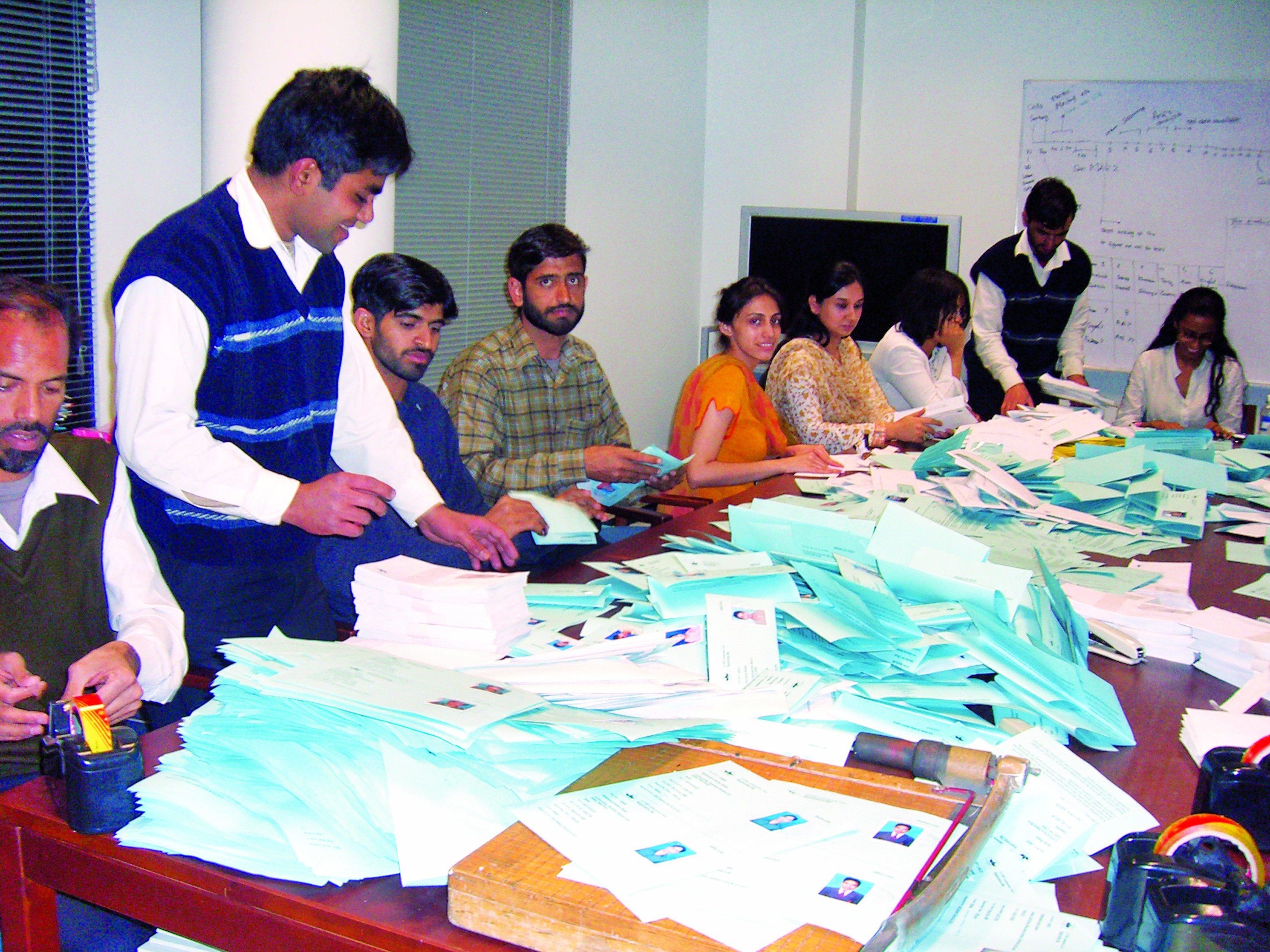
This would be a significant shift from the traditional undergraduate programmes in Pakistan, where students are admitted into majors, and there is practically no common coursework between the different streams. For example, if a student chooses the pre-medical stream then there is minimal exposure to Mathematics and similarly, there is no exposure to Biology for those who opt for the pre-engineering stream. At SSE, all students would be required to study one to two years of the fundamental sciences (Physics, Chemistry, Biology and Mathematics) regardless of their choice of major.
This design would ascertain that all SSE students would have a strong foundation in the sciences, something which the current system lacked.
SSE’s first Dean, Asad Abidi, arrived in July 2007, and activities designed to publicise the SSE and attract top-tier applicants for the first batch began soon thereafter. There was a concerted effort to build a distinct brand image for the school, which was also a first for LUMS. The small team of staff and faculty all put their heads together and numerous discussions, meetings and emails resulted in the design of the SSE mascot, a small robot figure affectionately named S2E. Shoa Malik, the graphic designer, is the one to be credited for successfully giving shape to the various ideas that were floated around. S2E was used in all the collateral and advertisements that the school submitted. All this occurred in conjunction with finalising the SSE core curriculum, working out the details of material to be delivered as lectures, recitations and tutorials, the preparation of laboratory manuals, ensuring the availability of chemicals and relevant equipment, the validation of experiments and development of the admission test and materials. Add to this the work of infrastructure development, faculty and staff hiring and then one may be able to visualise the beehive of activity that often saw the SSE offices lit up late into the night.
In November 2007, the SSE launch event was organised. Top students in a number of local schools had been identified and were sent personalised invitations. The attendance was overwhelming with more than 1200 attendees, including parents, students and a number of school teachers. The event started with Dr. Abidi introducing SSE and its faculty. He made a very passionate and inspiring speech describing how SSE was going to cause a paradigm shift in science education and how research would be a part of undergraduate education for the first time. This was followed by a spirited question and answer session that witnessed parents as enthused as the potential students; and heartening faith was evident in LUMS that it would indeed launch a school with facilities and faculty that would take science education to a higher level in Pakistan. Dr. Abidi worked in close collaboration with Sarah Mahmood to develop the plan for the event. He was a very enthusiastic leader, and wrote the invitation letter to the prospective students himself. Shahab Baqai, a member of the Computer Science faculty and one of the most involved advocates of SSE from within LUMS, also worked very hard to make the occasion a success. The night before the event, he and Sarah Mahmood were outside in the cold till 3 am, personally overseeing the tent setup and other details. Of course, none of it could have been possible without the help of the faculty and the eager group of student volunteers.
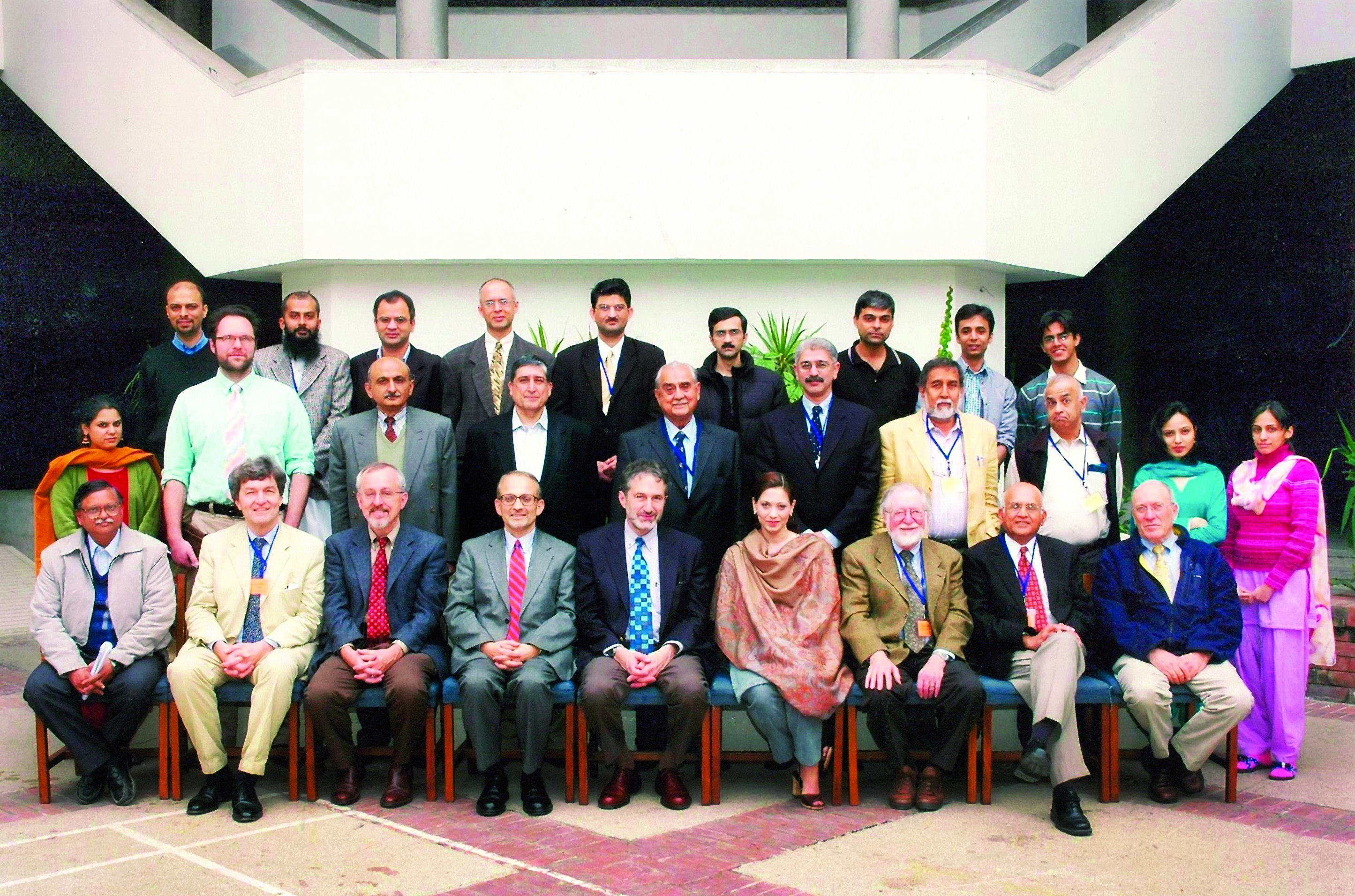
Following the SSE launch the first admissions cycle for SSE was opened. Hajira Kureshi had joined as the Admissions Manager, but admissions was a process which each and every member of the new school took ownership of, ranging from the Dean, to the faculty, to the administrative staff and even the office attendants who coordinated with the mailing office. In keeping with the need-blind admissions policy that was defined, paper applications with pre-paid envelopes were made available freely and multiple advertisements were placed in Urdu and English dailies. A concerted effort was made for outreach. Educational boards were contacted for names of top students, who were targeted by posting individually addressed letters and application forms. Information about SSE was disseminated to various private schools and admission applications were couriered free of cost to applicants who were based in remote areas. In short, a buzz was created about the new venture and in January 2008, SSE received more than 7000 applications, the largest number in the history of LUMS.
The LUMS mailing office was flooded with correspondence and the SSE offices literally received sacks of mail every day. Amusingly, the first task that grew to be overwhelming was simply the opening of all the packets received! As the volume grew to unmanageable numbers, a team of volunteers arrived from Packages Ltd. led by Sahil Zaheer which spent four working days merely opening the mailed packets and stapling the documents together! This was followed by the task of collating and sorting all the documents, the creation of physical files for each applicant, assignment of unique identifiers, data entry for tracking purposes and finally arranging all the files in a retrievable manner. Each applicant was sent an acknowledgement, with indicators in case there was any documentation missing. In retrospect, a simple mistake was the cause of this flood, being that each application packet came with separate pre-paid envelopes for each item, i.e. the admission information, the references and the financial aid data. This had been done quite intentionally to facilitate the applicants, but the volume had been unforeseen. The subsequent admission cycle enforced one envelope with all the relevant documents.
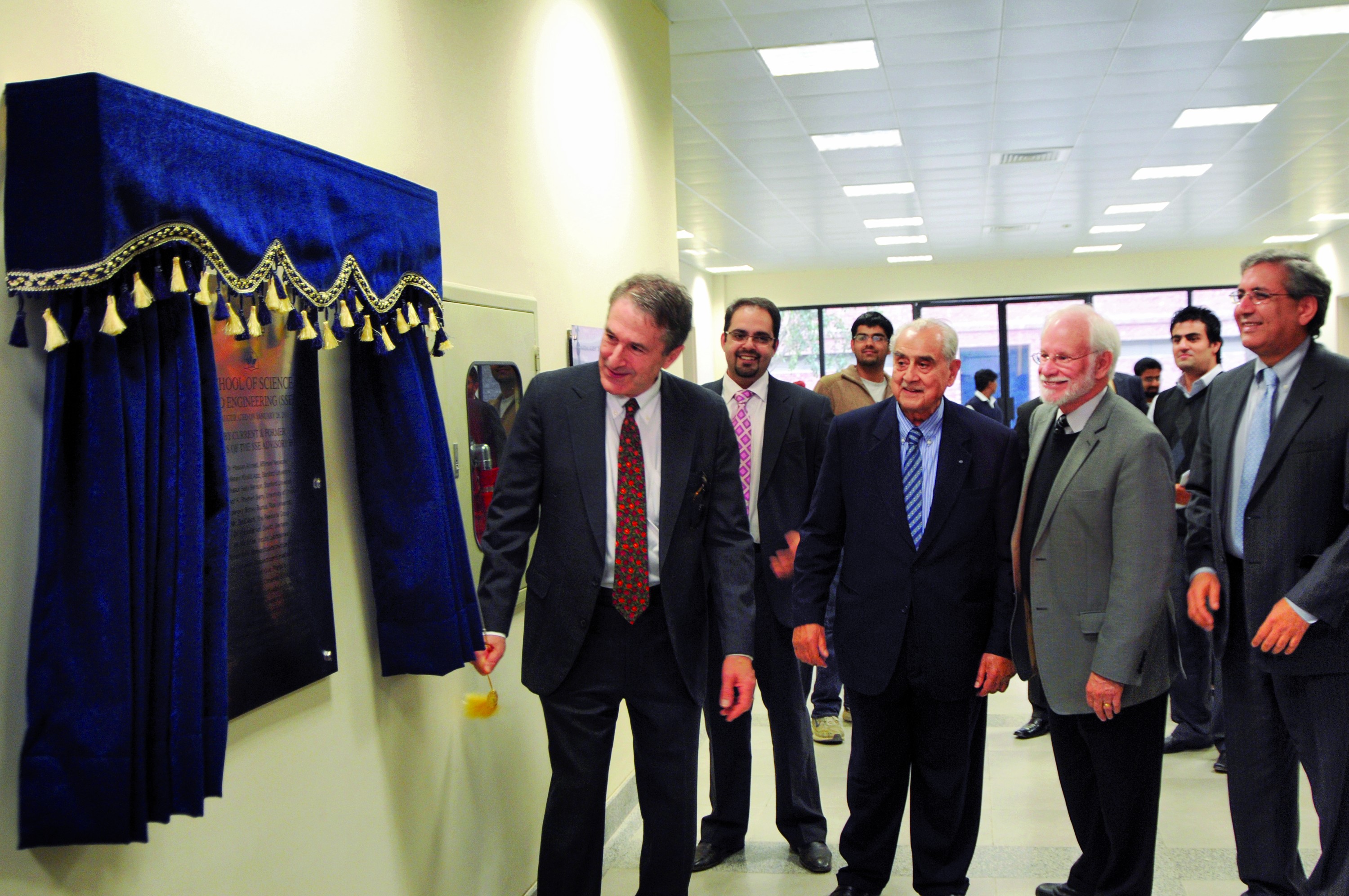
In a race against time, each of the applications was individually screened by faculty members, who considered every aspect of the application from the academic transcripts, to extra-curricular involvements, to the references and the personal statement. In Dr. Abidi’s words, the readers were reviewing the applications with “a jeweller’s eye” to ensure that no diamond in the rough slipped notice. Going through all these applications was a marathon effort, and would not have been possible without the commitment of faculty members including Khalid Rasheed (Chemistry), Zaeem Jafri (Mathematics), Shahab Baqai (Computer Science), Sohaib Khan (Computer Science) and Zartash Uzmi (Computer Science), who were often going through applications until the sun came up! This gargantuan endeavour resulted in 3100 students being shortlisted for the SSE entrance exam, once again a first in LUMS history. After individual interviews of the approximately 400 applicants who qualified, 173 students joined in October 2008 as the first BS Class of 2012. It may easily be claimed that the first admissions cycle brought all of SSE together as one unit for the first time, working on the same task simultaneously.
Parallel to these efforts was the rush to get the SSE building, especially lecture halls and labs, ready for the first batch of freshmen. Classes were started in October 2008 in the still under-construction SSE building. The students were excited by the new and demanding curriculum they were being taught by incredibly passionate teachers. They could be seen working with faculty late into the night in the SSE offices, on a regular basis. An instructor whose availability could be counted upon till at least 1 am was Asad Naqvi.
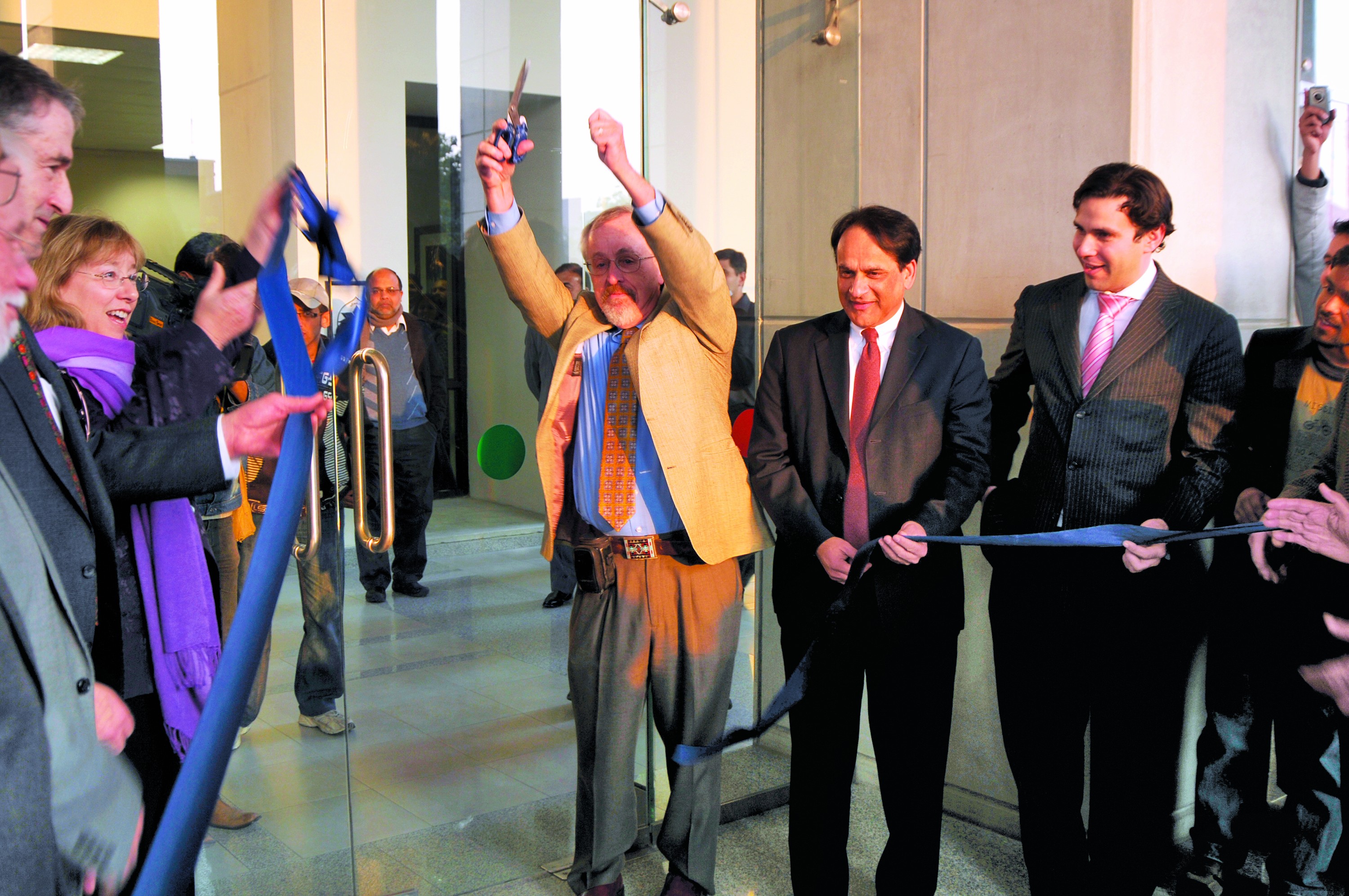
The in-progress SSE complex had one 200-seat auditorium functional on the third floor along with some lecture and discussion rooms, and the top floor of the building, allocated to Chemistry, was the site of the lab activity. The Chemistry and Biology experiments were held in the two teaching laboratories on that floor, whereas Sabieh Anwar developed a unique series of Physics experiments with customised equipment that was housed across the hallway. These experiments were later shared with other local universities in a knowledge exchange programme initiated by SSE. As the load of the rigorous, customised curriculum took its toll upon the pioneering batch, a number of faculty-student dialogues were conducted.
These sessions were reminiscent of the ‘pep talks’ that Javed Hamid held with the initial MBA batch. The students were encouraged to let off steam and share their problems. The attending faculty listened attentively and attempted to come up with resolutions which were mutually acceptable. In view of the anxiety caused by the demanding syllabus and inevitable long hours, Salal Humair took the initiative of creating a panel of faculty members who lived on campus and would be accessible for the students 24/7. This group comprised Asad Naqvi, Salal Humair, Zartash Uzmi and Shahab Baqai.
Challenges & Progress (2009-2010)
The singular commitment to a dream and the tireless dedication of the SSE project team had indeed managed to convert a bold vision into tangible realities. However, the new establishment had just taken off and its rapid momentum and enthusiasm needed to be balanced by consistency to continue on an upward trajectory.
On January 28, 2009, in conjunction with the Advisory Board meeting, a donor acknowledgement event “Celebrating SSE” was held. A dinner was arranged for all the generous donors who had helped SSE become a reality. The donors got a chance to meet with the members of the Advisory Board, the faculty and most importantly, the students which gave them a clear picture of the reality they had helped to achieve. Hassan Ahmed, member of the SSE Advisory Board, summed the journey thus far in the following words, “We all signed up to work for Syed Babar Ali’s inspiring vision to develop a world-class science and engineering school in Pakistan and it is incredibly gratifying to see the early stages of it.”
Unfortunately, all was not smooth sailing, as is inevitable with an undertaking of this magnitude. The introduction of the tenure-track system of faculty recruitment sparked the initial differences. The existing disciplines of Computer Science and Mathematics, whose natural home was SSE, felt marginalised. There was concern among their faculty regarding the transition to this system, and they were apprehensive about how their seniority of service would be measured by the new metric. This disconnect was compounded by the fact that both legacy departments, Computer Science and Mathematics, were physically located in different offices, and therefore, not part of the daily tumult of activity occurring at SSE. Meanwhile, the close-knit group at SSE was so preoccupied with the myriad tasks and deadlines at hand, that they were unable to do justice to the collaboration that goodwill required. At the same time, the successful fundraising that SSE had managed, revealed its flip side. The amount being spent on marketing and publicity was viewed by some as setting an excessive precedent. Moreover, owing to the unique nature of the enterprise, the new school had autonomy in certain administrative decisions. All these factors led to the escalation of issues and adversely affected internal politics within the new establishment.
The situation worsened after Dr. Abidi chose to resign in January 2009. This setback was multiply exacerbated when shortly thereafter Khurram Afridi had to relocate to the United States for family reasons. Subsequently, Dr. Humair also returned to Boston in the summer of 2009. The Dean search was re-launched and in the interim, Ahmad Jan Durrani, the Vice Chancellor, took over as Acting Dean for SSE. Both roles were extremely demanding, and the focus required for a fledgling school was exacting, therefore, Ahmad Jan Durrani enlisted Asad Naqvi as his ‘eyes and ears on the ground’ for a few months, until the latter left in August to pursue a fellowship. By September 2009 a suitable dean had been identified, but unfortunately, was unable to relocate to Pakistan for bureaucratic reasons and a year down the road, the SSE remained without a Dean at the helm.
In the meanwhile, Ahmad Jan Durrani, the Vice Chancellor and Acting Dean, conducted restructuring at the SSE in accordance with the norm across the rest of the University. This resulted in SSE admissions, financial aid and fundraising being centralised, and the relevant offices at SSE were abolished. The SSE Marketing Office was placed under the budget of the University Marketing department. A number of aspects pertaining to faculty recruitment were also moved to the central Human Resources Department, LUMS.
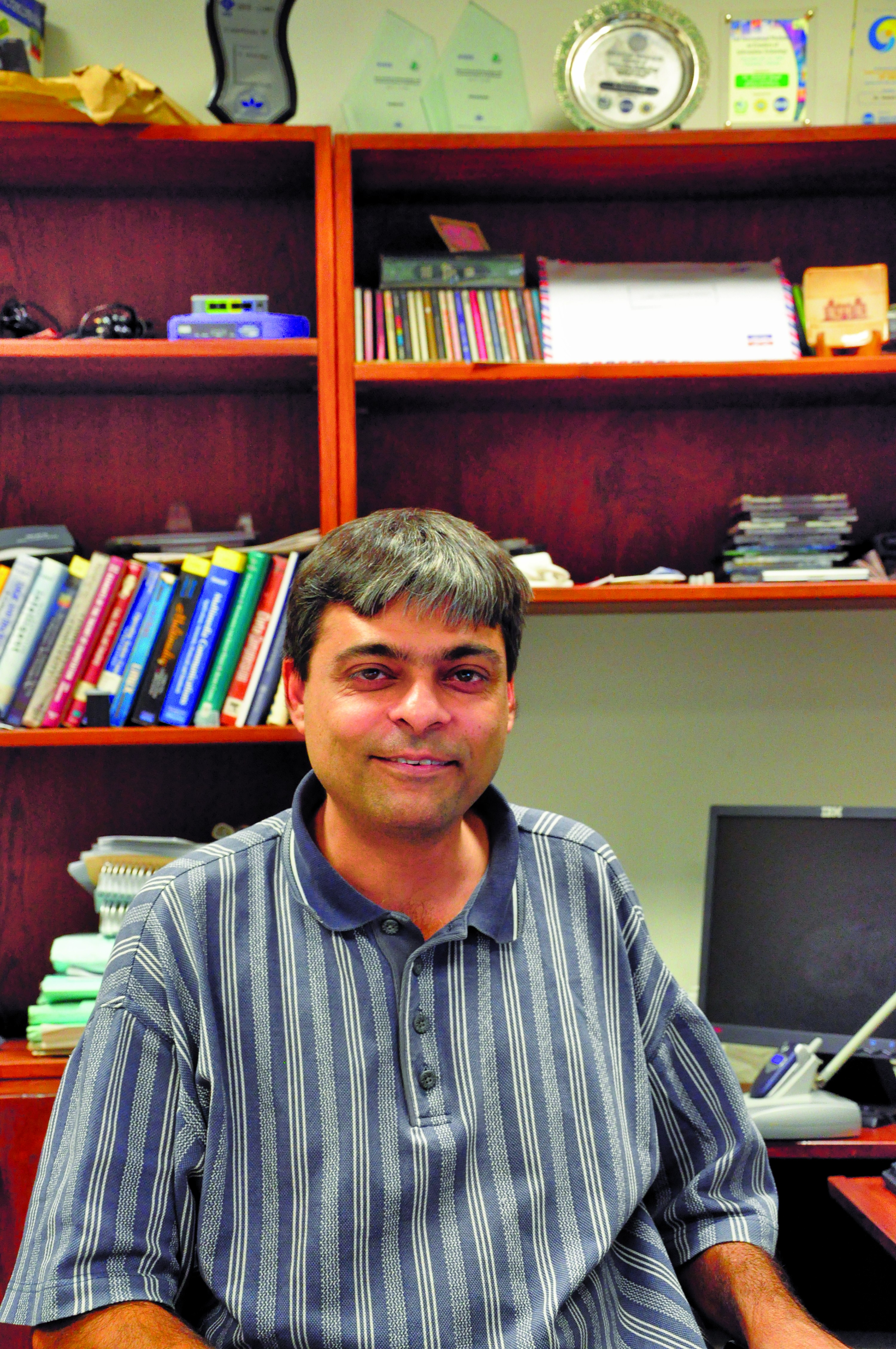
In the summer of 2010, Shahab Baqai, who was already serving as the Head of the Computer Science Department, was appointed Acting Associate Dean. In the past year there had been dismay and apprehension that the ambitious and inclusive vision that SSE had been working towards would be lost. So, Shahab Baqai’s appointment came as a huge relief because he had been closely associated with the project since its inception and held the confidence of all the stakeholders.
However, support from the staff and faculty was not all that Shahab Baqai needed to be an effective leader. He had inherited more than his fair share of challenges. The initial team that had actually set up the school was no longer on the ground; moreover, they had been so closely involved in all matters of practical implementation that without their oversight, processes that had not been formalised, seemed particularly chaotic. The public image and buzz around SSE had taken a big hit with the departure of Asad Abidi. And last but not least, in Shahab Baqai’s own words, people “…would always compare what I was doing with Asad Abidi and his shoes are unfillable!”.
It is due to the commitment of the small group of faculty and staff that, despite this upheaval, progress continued at the SSE. Classes were continuing smoothly and a fresh batch of students had been admitted. SSE had put an effective counselling system in place, in which faculty members were assigned to students to offer guidance which ranged from course management, to advice on choice of major and settling-in concerns. Integration of the two legacy departments, Computer Science and Mathematics, was completed. The construction of the SSE Complex was progressing. In keeping with the research philosophy of SSE, the departments of Biology, Chemistry, Computer Science and Physics were especially active in forging research collaborations as well as maintaining external academic and industrial linkages. In November 2010, Ahmad Jan Durrani, the Vice Chancellor, requested Shahab Baqai to take over as Acting Dean of SSE.
Concluding Notes
January 26, 2011 marked an important event in LUMS’ history, as it marked the 25th anniversary of the institute and the SSE Complex was formally inaugurated on the same day. As mentioned earlier, the plans for the 300,000 sq ft, state-of-the-art building were drawn up by the renowned architect, Habib Fida Ali. The plans were based on the facilities programme developed by Dr. Afridi, in collaboration with Dober Lidsky, Craig and Associates, a prominent, Boston-based, campus-planning firm. In addition to this structure, there was a 25,000 sq ft physical plant, a 10MW grid station and a pH Neutralization Plant to ascertain complete and responsible disposal of the chemical waste materials which would be generated. It would not at all be far-fetched to claim that no similar building exists in Pakistan, with the comprehensive ducting for hot water, natural gas, compressed air and nitrogen and the elaborate level of vibration control.
The annual SSE Advisory Board meeting was held to coincide with this momentous event. It was a grand event attended by faculty, students, donors, local corporate executives and academicians. Members of the Advisory Board, who had been involved with SSE since its inception, were present to do the honours: Dr. Richard Larson and Dr. Hassan Ahmed cut the ribbon on the occasion and Dr. Robert Jaffe unveiled the plaque. Syed Babar Ali, Pro Chancellor, Abdul Razak Dawood, Rector and Ahmad Jan Durrani, Vice Chancellor also spoke on the occasion.
In November of the same year, Shahab Baqai stepped down as the Acting Dean and Sohail Asif Qureshi took over as Dean of SSE. Since the departure of Asad Abidi in January 2009, this was the first time that there was no ambiguity in the leadership structure of the young school.

The landmark event of 2012 was the graduation of the first batch of SSE students on June 23, 2012. The 24th Convocation of LUMS was special also because it was the largest convocation ceremony in the University’s history, with over 700 students in the graduating class. The celebrations started an evening earlier, with a formal dinner organised for the graduates who achieved distinctions in their respective subject areas and those placed on the Deans’ Honour Lists. These students were presented with medals and shields in the presence of proud and beaming parents. The convocation ceremony itself was held at the Syed Maratib Ali Sports Complex. Degrees were conferred on the graduates and gold and silver medals were awarded to graduates securing top positions in various programmes. The keynote address was delivered by the young filmmaker Sharmeen Obaid-Chinoy, who had won Pakistan’s first Academy Award earlier that year. A lot of hopes are riding on the 150 pioneering graduates of SSE. Fifteen of the students were accepted in doctoral programmes at prestigious institutes including Harvard University, USA, University of Illinois at Urbana-Champaign, USA, New York University, USA, Dartmouth University, USA, Max-Planck Institute, Germany and University of Oxford, UK. Two graduates had full time job offers from Microsoft Ltd., even before the completion of their degree.
Dr. Jaffe, member of the Advisory Board, narrates how the students were the ultimate manifestation of what SSE had been striving for, “It was wonderful. I talked to them about my research and I saw their enthusiasm; they came up afterwards, they wouldn’t let me go! They wanted to know everything about quantum mechanics, quantum field theory and it was just delightful!” And “Looking at the students, you may not see it the same way I do, but the audience consisted of every size, shape, colour and dress style you could imagine. There were people who were completely invisible except for a slot for their eyes and there were other students in blue jeans and t-shirts and I thought to myself ‘That’s what the whole thing was for!’”

